02.12.24

5 Leadership Lessons: The Pursuit of Excellence
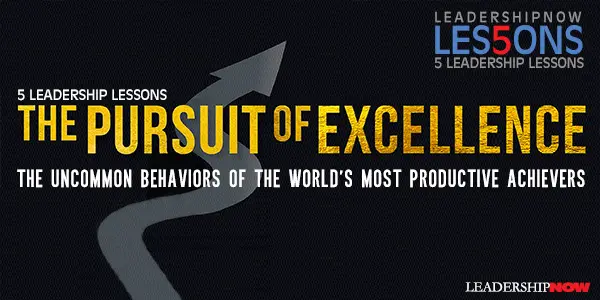
RYAN HAWK has interviewed hundreds of leaders on his podcast The Learning Leader Show. He has collected their wisdom in The Pursuit of Excellence: The Uncommon Behaviors of the World’s Most Productive Achievers. It is filled with practical thoughts and behaviors that will make you think and potentially set you on a path to sustained growth. Here are just five ideas he shares from those on his podcast:
 Success is based on a comparison with others. Excellence is measured against your own potential. Success is based on a comparison with others. Excellence is measured against your own potential.
 The worst advice given to young people is follow your passion. Your job is to find something you’re good at. And then spend thousands of hours and apply the grit and the sacrifice and the willingness to break through hard things to become great at it. Because once you’re great at something, the economic accouterments of being great at something, the prestige, the relevance, the camaraderie, the self-worth of being great … will make you passionate about whatever it is. Here’s the problem with believing you should follow your passion: Work is hard. And when you run into obstacles and you face injustice, which is a common guaranteed attribute of the workplace, you’ll start thinking, “I’m not loving this. This is upsetting and hard. It must not be my passion.” That is not the right litmus test. The worst advice given to young people is follow your passion. Your job is to find something you’re good at. And then spend thousands of hours and apply the grit and the sacrifice and the willingness to break through hard things to become great at it. Because once you’re great at something, the economic accouterments of being great at something, the prestige, the relevance, the camaraderie, the self-worth of being great … will make you passionate about whatever it is. Here’s the problem with believing you should follow your passion: Work is hard. And when you run into obstacles and you face injustice, which is a common guaranteed attribute of the workplace, you’ll start thinking, “I’m not loving this. This is upsetting and hard. It must not be my passion.” That is not the right litmus test.
 New goals don’t deliver new results. New lifestyles do. And a lifestyle is not an outcome. It is a process. New goals don’t deliver new results. New lifestyles do. And a lifestyle is not an outcome. It is a process.
 The best leaders know how messy they are. They challenge themselves. They have a high level of self-awareness. They know they need people around them to help. They acknowledge their imperfections, and they give others grace for their imperfections. The best leaders know how messy they are. They challenge themselves. They have a high level of self-awareness. They know they need people around them to help. They acknowledge their imperfections, and they give others grace for their imperfections.
 Progress happens too slowly to notice; setbacks happen too fast to ignore. There are lots of overnight tragedies but no overnight miracles. Growth is driven by compounding, which always takes time. Destruction is driven by single points of failure, which can happen in seconds, and loss of confidence, which can happen in an instant. Progress happens too slowly to notice; setbacks happen too fast to ignore. There are lots of overnight tragedies but no overnight miracles. Growth is driven by compounding, which always takes time. Destruction is driven by single points of failure, which can happen in seconds, and loss of confidence, which can happen in an instant.
* * *  Follow us on Instagram and Twitter for additional leadership and personal development ideas.
* * *


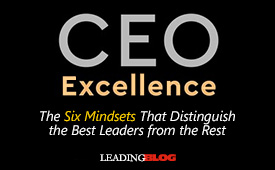 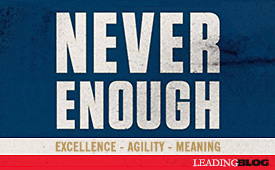
Posted by Michael McKinney at 10:05 AM
Permalink
| Comments (0)
| Five Lessons
07.10.23

5 Leadership Lessons: Larry Thornton: Reflections on a Fifty-Year Journey from the Segregated South to America’s Board Rooms
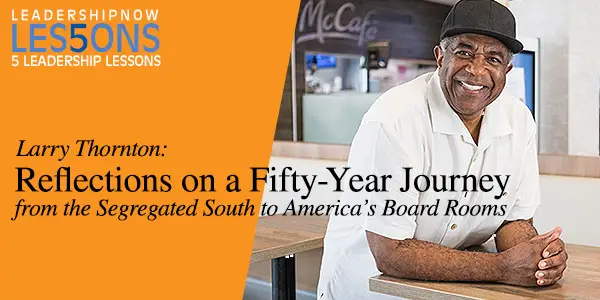
ARTIST AND ENTREPRENEUR Larry D. Thornton says growing up with brown skin in the 1960s in segregated Montgomery, Alabama, he was “socially and internally maladjusted.” He was often angry because “for every single day, essentially everything around him reminded him that he was inferior for no other reason than being born.” He says, “For that reason, I rejected school and disregarded and discounted people with white skin. It was a dangerous road I was on, and I was headed along full throttle.”
But over time, his thinking changed due to the caring people around him that provided encouragement. He decided, why not win. “Today,” he writes, “I know that my change in thinking rewrote my history. Since then, I have been immensely fortunate and blessed with a wealth of opportunities—beyond my imagination and more than I deserve.”
Beginning as a sign painter for the local Coca-Cola bottling company, he would become the first and only African American to serve on the company’s board of directors. He was also the first African American to own a McDonald’s franchise in Birmingham, Alabama, among other firsts on his journey.
In Why Not Win? Reflections On a Fifty-Year Journey from the Segregated South to America’s Board Rooms – And What It Can Teach Us All, Thornton shares stories from his life and pulls the key lessons that shaped him into the person he is today. Here are only five of the 21 life lessons Thornton shares with us:
 No matter how many opportunities or accolades you receive, or whether your beginnings are humbled or privileged, you can never give ‘too much’ to others in genuine need. Who was it that said, ‘Where much is given, much is required?’ That is how you really win—by giving to others and setting them up to be winners as well. No matter how many opportunities or accolades you receive, or whether your beginnings are humbled or privileged, you can never give ‘too much’ to others in genuine need. Who was it that said, ‘Where much is given, much is required?’ That is how you really win—by giving to others and setting them up to be winners as well.
 If you can’t take anything, then you can’t have anything. The more you can take, the more you can have. I had to learn how to keep my eyes on the prize, as the rewards of life are reserved only for those who stay in the game. If you can’t take anything, then you can’t have anything. The more you can take, the more you can have. I had to learn how to keep my eyes on the prize, as the rewards of life are reserved only for those who stay in the game.
 Find your center and operate from it. Use, follow, adhere to the guidelines of life. They were meant to steer you toward successful living. In most instances, ‘attention’ is all that you will have to pay. Surely you can afford that? Find your center and operate from it. Use, follow, adhere to the guidelines of life. They were meant to steer you toward successful living. In most instances, ‘attention’ is all that you will have to pay. Surely you can afford that?
 People will listen to your actions far more carefully than they will your words. Your actions will reflect the significance or insignificance of your words. Some of the most pointed messages that you will ever communicate will occur without the employment of a single word. Let your actions, gestures, and deeds speak clearly. And remember—whoever said ‘those who deserve love the least, need love the most’ certainly knew what he or she was talking about. People will listen to your actions far more carefully than they will your words. Your actions will reflect the significance or insignificance of your words. Some of the most pointed messages that you will ever communicate will occur without the employment of a single word. Let your actions, gestures, and deeds speak clearly. And remember—whoever said ‘those who deserve love the least, need love the most’ certainly knew what he or she was talking about.
 The ugly truth too often reveals itself: ‘I want to do what you do, but I am not willing to do what you did.’ It is not as much about the ‘doing’ as much as it is about the ‘did.’ The ‘did’ is where the value is. Be willing to withstand the heat of the fire. Bear the winds and rains of the storms, then rest in the assurance that the impending blue skies and sunshine will take care of themselves. The ugly truth too often reveals itself: ‘I want to do what you do, but I am not willing to do what you did.’ It is not as much about the ‘doing’ as much as it is about the ‘did.’ The ‘did’ is where the value is. Be willing to withstand the heat of the fire. Bear the winds and rains of the storms, then rest in the assurance that the impending blue skies and sunshine will take care of themselves.
* * *  Follow us on Instagram and Twitter for additional leadership and personal development ideas.
* * *


 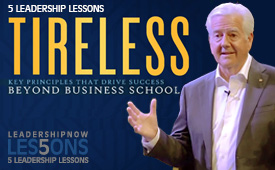
Posted by Michael McKinney at 06:37 AM
Permalink
| Comments (0)
| Five Lessons
03.16.22

5 Leadership Lessons: The Five B’s of Purposeful Leadership
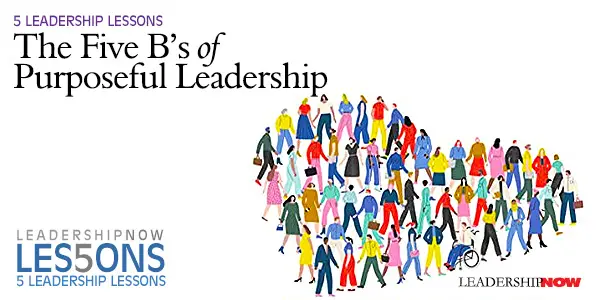
IN The Heart of Business: Leadership Principles for the Next Era of Capitalism, former CEO of Best Buy, Hubert Joly, shares the philosophy behind the resurgence of Best Buy: pursue a noble purpose, put people at the center of the business, create an environment where every employee can blossom, and treat profit as an outcome, not the goal.
He shares what he learned and what he had to unlearn. How we lead matters. He concludes with the five principles of purposeful leadership that guided his leadership.
 Be clear about your purpose, the purpose of people around you, and how it connects with the purpose of the company. I believe that business is fundamentally about purpose, people, and human relationships—not profit, at least not primarily. Companies are not soulless entities. They are human organizations made of individuals who work together toward a common purpose. When that common purpose aligns with their own individual searches for meaning, it can unleash a kind of human magic that results in outstanding performance. Be clear about your purpose, the purpose of people around you, and how it connects with the purpose of the company. I believe that business is fundamentally about purpose, people, and human relationships—not profit, at least not primarily. Companies are not soulless entities. They are human organizations made of individuals who work together toward a common purpose. When that common purpose aligns with their own individual searches for meaning, it can unleash a kind of human magic that results in outstanding performance.
 Be clear about your role as a leader. You cannot choose your circumstances, but you can control your mindset. Your mindset determines whether you generate hope, inspiration, and energy around you—or bring everyone down. So, choose well. Be clear about your role as a leader. You cannot choose your circumstances, but you can control your mindset. Your mindset determines whether you generate hope, inspiration, and energy around you—or bring everyone down. So, choose well.
 Be clear about whom you serve. As a leader, you must serve the people on the front lines, driving the business. You serve your colleagues. You serve your board of directors. You serve the people around you first by understanding what they need to give their best, so you can do your best to support them. Executive coach Marshall Goldsmith once told me to see everyone as a customer. Before speaking or acting, be clear about your motivation and whom you are trying to serve. Be clear about whom you serve. As a leader, you must serve the people on the front lines, driving the business. You serve your colleagues. You serve your board of directors. You serve the people around you first by understanding what they need to give their best, so you can do your best to support them. Executive coach Marshall Goldsmith once told me to see everyone as a customer. Before speaking or acting, be clear about your motivation and whom you are trying to serve.
 Be driven by values. For the most part, we all agree on what is right: honesty, respect, responsibility, fairness, and compassion. On paper, every company has great values. But values are no good if they remain on paper. Bing driven by values is doing right, not just knowing or saying what is right. Knowing and doing what is right is not always simple, of course. If you refuse to give in to the “just this once” and remember to tell the truth and do what is right, choices become easier. Be driven by values. For the most part, we all agree on what is right: honesty, respect, responsibility, fairness, and compassion. On paper, every company has great values. But values are no good if they remain on paper. Bing driven by values is doing right, not just knowing or saying what is right. Knowing and doing what is right is not always simple, of course. If you refuse to give in to the “just this once” and remember to tell the truth and do what is right, choices become easier.
 Be authentic. I have been told the longest journey you’ll ever take is the 18 inches between your head and your heart. It is a long and arduous journey indeed. Like make leaders of my generation, I long believed emotions were not meant to be shared in a business context. I had a lot to unlearn, and it took me a lifetime to embrace the fifth, and for me by far the hardest, “Be”: Ne yourself, your true self, your whole self, the best version of yourself. Be vulnerable. Be authentic. This is something the new generation of leaders seems to grasp more intuitively and naturally. Be authentic. I have been told the longest journey you’ll ever take is the 18 inches between your head and your heart. It is a long and arduous journey indeed. Like make leaders of my generation, I long believed emotions were not meant to be shared in a business context. I had a lot to unlearn, and it took me a lifetime to embrace the fifth, and for me by far the hardest, “Be”: Ne yourself, your true self, your whole self, the best version of yourself. Be vulnerable. Be authentic. This is something the new generation of leaders seems to grasp more intuitively and naturally.
Our employees are expecting us to be human, and they expect us to grasp who they are and to make them feel respected, heard, understood, and included. This means we have to open up and make ourselves vulnerable, including by acknowledging what we do not know.
* * *  Follow us on Instagram and Twitter for additional leadership and personal development ideas.
* * *


 
Posted by Michael McKinney at 08:55 AM
Permalink
| Comments (0)
| Five Lessons
, General Business
05.24.21

5 Leadership Lessons: The Bomber Mafia

THE IDEA of conducting an air war was born from the traumatic and tragic lessons learned from World War 1. The goal was to help make the deadly, wasteful, pointless conflict on the ground obsolete with precision bombing. The precision part was the problem until Carl Norden came along and invented a bombsight for more accuracy. It would begin to change how we fought wars. Strategic bombing from high altitude, in daylight, with precision bombing to make war less lethal.
The Bomber Mafia: A Dream, A Temptation, and The Longest Night of the Second World War by Malcolm Gladwell is a story about “the messiness of our intentions.” The Bomber Mafia was born from new technology—airpower. It was their belief that “We don’t have to slaughter the innocent, burn them beyond recognition, in pursuit of our military goals. We can do better.” Their belief did not die but was put on hold in the early morning hours of March 10, 1945, on what became the longest night of World War 2. On that night, 279 B-29’s dropped incendiary bombs on Tokyo, Japan.
Gladwell asks, “How is it that, sometimes, for any number of unexpected and random reasons, technology slips away from its intended path?” The Bomber Mafia held to their belief. “They persisted, even in the face of technology’s inevitable misdirection, even when abandoning their dream offered a quicker path to victory, even when Satan offered them all the world if only they would renounce their faith. Without persistence, principles are meaningless. Because one day your dream may come true. And if you cannot keep that dream alive in the interim, then who are you?”

 “I like the idea that someone could push away all the concerns and details that make up everyday life and just zero in on one thing—the thing that fits the contours of his or her imagination. Obsessives lead us astray sometimes. Can’t see the bigger picture. Serve not just the world’s but also their own narrow issues. But I don’t think we get progress or innovation or joy or beauty without obsessives.” “I like the idea that someone could push away all the concerns and details that make up everyday life and just zero in on one thing—the thing that fits the contours of his or her imagination. Obsessives lead us astray sometimes. Can’t see the bigger picture. Serve not just the world’s but also their own narrow issues. But I don’t think we get progress or innovation or joy or beauty without obsessives.”
 Professor Stephen McFarland, when asked if Carl Norden, the inventor of the bombsight, was a genius, said, “He would tell you that only God invents; humans discover. So for him, is was not genius. He would say he’s just one who discovers the greatness of God, the creations of God; that God reveals truth through people who are willing to work hard and to use their minds to discover God’s truths.” Professor Stephen McFarland, when asked if Carl Norden, the inventor of the bombsight, was a genius, said, “He would tell you that only God invents; humans discover. So for him, is was not genius. He would say he’s just one who discovers the greatness of God, the creations of God; that God reveals truth through people who are willing to work hard and to use their minds to discover God’s truths.”
 “Revolutions are invariably group activities. Rarely does someone start a revolution alone. Revolutions are birthed in conversation, argument, validation, proximity, and the look in your listener’s eye that tells you you’re on to something. Conversation starts to seed a revolution. The group starts to wander off in directions in which no one individual could ever have conceived of going all by himself or herself.” “Revolutions are invariably group activities. Rarely does someone start a revolution alone. Revolutions are birthed in conversation, argument, validation, proximity, and the look in your listener’s eye that tells you you’re on to something. Conversation starts to seed a revolution. The group starts to wander off in directions in which no one individual could ever have conceived of going all by himself or herself.”
 Frederick Lindemann (Lord Cherwell) was Winston Churchill’s best friend. He excelled where Churchill didn’t. Churchill stored anything to do with the quantitative world in Lindemann’s head. “Transactive Memory, which is the observation that we don’t just store information in our minds or in specific places. We also store memories and understanding in the minds of the people we love. You don’t need to remember your child’s emotional relationship to her teacher because you know your wife will; you don’t have to remember how to work the remote because your daughter will. That’s transactive memory. Little bits of ourselves reside in other people’s minds.” Frederick Lindemann (Lord Cherwell) was Winston Churchill’s best friend. He excelled where Churchill didn’t. Churchill stored anything to do with the quantitative world in Lindemann’s head. “Transactive Memory, which is the observation that we don’t just store information in our minds or in specific places. We also store memories and understanding in the minds of the people we love. You don’t need to remember your child’s emotional relationship to her teacher because you know your wife will; you don’t have to remember how to work the remote because your daughter will. That’s transactive memory. Little bits of ourselves reside in other people’s minds.”
 What happens to true believers when their convictions are confronted by reality? “The more you invest in a set of beliefs—the greater the sacrifice you make in service of that conviction—the more resistant you will be to evidence that suggests that you are mistaken. You don’t give up. You double down.” What happens to true believers when their convictions are confronted by reality? “The more you invest in a set of beliefs—the greater the sacrifice you make in service of that conviction—the more resistant you will be to evidence that suggests that you are mistaken. You don’t give up. You double down.”
* * *  Like us on Instagram and Facebook for additional leadership and personal development ideas.
* * *


 
Posted by Michael McKinney at 09:25 AM
Permalink
| Comments (0)
| Five Lessons
03.11.20

5 Leadership Lessons: Tireless—Key Principles That Drive Success Beyond Business School
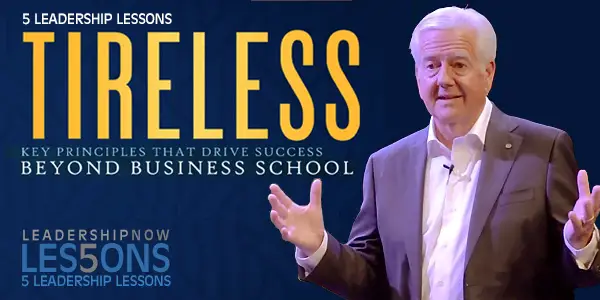
YOUR NEXT DECISION could dictate the trajectory you take. In Tireless, Kim Lorenz encourages us to look for opportunities both as an entrepreneur and in the company where we work, that will propel us to success.
Lorenz co-founded two companies that he eventually sold to Fortune 500’s. He shares his experiences and those of others to give us a picture of the principles that bring success and the mindset required to see the opportunities in front of us. Here are five thoughts from Kim Lorenz:
 “You and only you, make the choices you make. Believing in opportunity, and believing that opportunities are in front of you all the time, helps you make better decisions and look for what is in front of you yet often not visualized. It is the leaders—those who see the opportunity disguised as a problem—who think through solutions and become partners in the positive changes needed. You can make that decision to be part of positive change, and you can start today.” “You and only you, make the choices you make. Believing in opportunity, and believing that opportunities are in front of you all the time, helps you make better decisions and look for what is in front of you yet often not visualized. It is the leaders—those who see the opportunity disguised as a problem—who think through solutions and become partners in the positive changes needed. You can make that decision to be part of positive change, and you can start today.”
 “Improving your mental attitude opens your eyes to better opportunities and allows you to visualize positive steps that you might not otherwise see. We all hear the glass is half-empty to some, while half-full to others. Thinking along the more positive, ‘half-full’ scenario leads to looking for the rest of an opportunity as opposed to thinking negatively and waiting for the remainder of the negative. Your subconscious never rests, so it is important to be aware and try to use it as a positive force. Look for opportunity that is there. Your self-talk is with you all the time. Make it positive. Only you can make the choice and set the direction for your self-talk.” “Improving your mental attitude opens your eyes to better opportunities and allows you to visualize positive steps that you might not otherwise see. We all hear the glass is half-empty to some, while half-full to others. Thinking along the more positive, ‘half-full’ scenario leads to looking for the rest of an opportunity as opposed to thinking negatively and waiting for the remainder of the negative. Your subconscious never rests, so it is important to be aware and try to use it as a positive force. Look for opportunity that is there. Your self-talk is with you all the time. Make it positive. Only you can make the choice and set the direction for your self-talk.”
 “’This might work,’ discipline involves making the choice to get off your butt and do something. That ‘doing’ could be learning and applying that knowledge, trying something new or going full-out on a business idea. Simple discipline can be applied to any person, in any situation. Simply put, it is developing a habit of questioning everything; not accepting things as they seem to be, and asking yourself why they are not. Discipline also involves taking initiative and taking the first steps to imagine and create what you think might be possible. As the Nike slogan says, Just Do It! When you are dreaming of something you really want to do, start thinking about what the first step is and take that step. You will not only feel better, but you will also likely commit to accomplishing more. Only you can choose to strive to do more in any situation. Do not worry about what blunders might ensure. Work through them and find the opportunity that results.” “’This might work,’ discipline involves making the choice to get off your butt and do something. That ‘doing’ could be learning and applying that knowledge, trying something new or going full-out on a business idea. Simple discipline can be applied to any person, in any situation. Simply put, it is developing a habit of questioning everything; not accepting things as they seem to be, and asking yourself why they are not. Discipline also involves taking initiative and taking the first steps to imagine and create what you think might be possible. As the Nike slogan says, Just Do It! When you are dreaming of something you really want to do, start thinking about what the first step is and take that step. You will not only feel better, but you will also likely commit to accomplishing more. Only you can choose to strive to do more in any situation. Do not worry about what blunders might ensure. Work through them and find the opportunity that results.”
 “Many who have made it to the top sometimes get into a familiar rut, going through each day the same as the day before. They made it to the top position, perhaps as CEO, and then their goals to achieve more are just not as appealing to them. [See Are You Leading for the Right Reasons?] At the same time, other CEO’s continue to improve, add value to the business, expand, and do great things. They too must continually improve and find new ways to do business. We all put on our pants the same way, after all. The difference is what you mentally establish regarding what you need to do and your level of follow-through. Continual success requires the tireless discipline to do it; taking the time to write down the goals. This is what makes the difference between the ordinary leader and the exceptional, growing leader.” “Many who have made it to the top sometimes get into a familiar rut, going through each day the same as the day before. They made it to the top position, perhaps as CEO, and then their goals to achieve more are just not as appealing to them. [See Are You Leading for the Right Reasons?] At the same time, other CEO’s continue to improve, add value to the business, expand, and do great things. They too must continually improve and find new ways to do business. We all put on our pants the same way, after all. The difference is what you mentally establish regarding what you need to do and your level of follow-through. Continual success requires the tireless discipline to do it; taking the time to write down the goals. This is what makes the difference between the ordinary leader and the exceptional, growing leader.”
 “In both business and personal relationships, the bottom line is the same: how you treat people is always a reflection on you. A genuine, self-confident person treats all people the same, regardless of position, gender, race, or social status. Every person has their own story, their own struggles, and their own hopes and dreams. While we realistically cannot listen to all of them, we can make a better effort to get to know the people around us.”
“In both business and personal relationships, the bottom line is the same: how you treat people is always a reflection on you. A genuine, self-confident person treats all people the same, regardless of position, gender, race, or social status. Every person has their own story, their own struggles, and their own hopes and dreams. While we realistically cannot listen to all of them, we can make a better effort to get to know the people around us.”
* * *  Like us on Instagram and Facebook for additional leadership and personal development ideas.
* * *


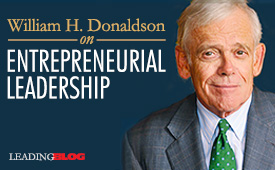 
Posted by Michael McKinney at 07:45 PM
Permalink
| Comments (0)
| Entrepreneurship
, Five Lessons
03.09.20

5 Leadership Lessons: Built Not Born
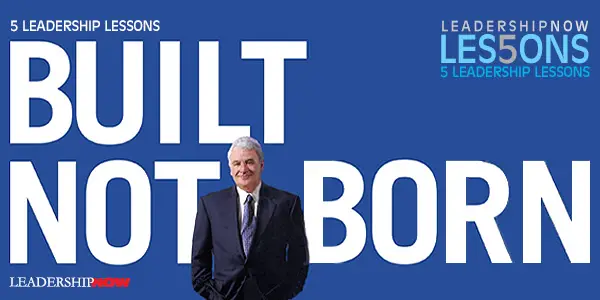
IF you are considering starting your own business or struggling to get one off the ground, Tom Golisano’s Built Not Born will be very valuable. Entrepreneurship is not easy, but it can be rewarding, provided you keep some basic business principles in mind.
With $3000 and a credit card in hand, Tom Golisano started what has become today the multi-billion-dollar Paychex. Golisano takes us through what he experienced from start to finish, what not to forget, and what the business owner is responsible for and the importance of understanding every aspect of your business.
Much of the advice is obvious, but in the thick of running a business, all too easy to forget. And Golisano keeps the critical issues front and center. “Running a business, any business, means challenges, some expected and others that come out of the blue. It comes with the territory. It’s an old aphorism, but it’s true nevertheless: If you can’t stand the heat, get out of the kitchen.” While entrepreneurship is not for everyone, going in well-informed is essential to success.
 The Business Plan: It’s easy to let passion cloud your judgment. “That’s the myth many business books peddle: ‘Follow your passion,’ or ‘Believe it and you’ll achieve it.’ That sort of thinking can lead you down a dangerous path. The most important thing when planning your business should be the accuracy of your facts and statistics. Another important thing not only to understand but to accept with every fiber of your being is that a first-rate business plan can often tell you not to start the business at all but run away and run fast. It’s critical that you take a hard look at the actual numbers and be candid with yourself about what they are telling you.” The Business Plan: It’s easy to let passion cloud your judgment. “That’s the myth many business books peddle: ‘Follow your passion,’ or ‘Believe it and you’ll achieve it.’ That sort of thinking can lead you down a dangerous path. The most important thing when planning your business should be the accuracy of your facts and statistics. Another important thing not only to understand but to accept with every fiber of your being is that a first-rate business plan can often tell you not to start the business at all but run away and run fast. It’s critical that you take a hard look at the actual numbers and be candid with yourself about what they are telling you.”
 Financials: “If you don’t understand financial statements, you are running your business blindfolded. I think many entrepreneurs get into trouble simply because they don’t understand their financial statements, of which the balance sheet and the profit and loss statement are the most important. If you know your numbers, you know your business. Any entrepreneur who does not understand financial statements is in great danger.” Financials: “If you don’t understand financial statements, you are running your business blindfolded. I think many entrepreneurs get into trouble simply because they don’t understand their financial statements, of which the balance sheet and the profit and loss statement are the most important. If you know your numbers, you know your business. Any entrepreneur who does not understand financial statements is in great danger.”
 Cash Flow: “If your business is short of cash, the first place to look is at your sales productivity. Cash flow problems are a direct result of not generating enough revenue through sales. Therefore, they are actually a sales problem, not a cash flow problem. The biggest mistake entrepreneurs make is a tendency to overestimate their ability to sell their product or service.” Cash Flow: “If your business is short of cash, the first place to look is at your sales productivity. Cash flow problems are a direct result of not generating enough revenue through sales. Therefore, they are actually a sales problem, not a cash flow problem. The biggest mistake entrepreneurs make is a tendency to overestimate their ability to sell their product or service.”
 Business Knowledge: “Often, entrepreneurs not only have large gaps in their business knowledge and experience but also are completely blind to their deficiencies. If you want to improve your chances of success, be honest with yourself and recognize the weaknesses in your business education and your business acumen, and seek help from a mentor or take courses to learn what you need to know. Business Knowledge: “Often, entrepreneurs not only have large gaps in their business knowledge and experience but also are completely blind to their deficiencies. If you want to improve your chances of success, be honest with yourself and recognize the weaknesses in your business education and your business acumen, and seek help from a mentor or take courses to learn what you need to know.
When you think of a thoroughbred racehorse, no matter how good it is, no matter its lineage or pedigree, it won’t win races if it’s ridden by a poor jockey. The same can be said of a business.”
 Family: “A common regret I am sure I share with many entrepreneurs is not spending as much time with my family as I should have. This a tough one because you are working hard building your company so that you can provide a better standard of living for your spouse and children. However, I do regret not finding a better balance. Work-life balance has become a big thing in business in recent years, and I’m not sure how qualified I am in giving advice on the subject, but remember it’s no good being successful and having no one with whom to share that success.” Family: “A common regret I am sure I share with many entrepreneurs is not spending as much time with my family as I should have. This a tough one because you are working hard building your company so that you can provide a better standard of living for your spouse and children. However, I do regret not finding a better balance. Work-life balance has become a big thing in business in recent years, and I’m not sure how qualified I am in giving advice on the subject, but remember it’s no good being successful and having no one with whom to share that success.”
Always keep in mind, a lasting legacy is built on we, not I.
* * *  Like us on Instagram and Facebook for additional leadership and personal development ideas.
* * *


 
Posted by Michael McKinney at 08:02 AM
Permalink
| Comments (0)
| Entrepreneurship
, Five Lessons
06.03.19

5 Leadership Lessons: Think Like Amazon
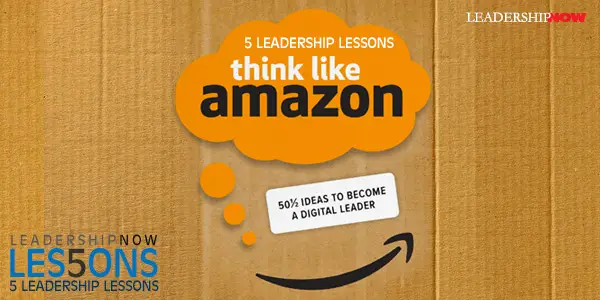
LONG-TERM THINKING is the key to what goes on at Amazon. Jeff Bezos has said, “What we’re really focused on is thinking long-term, putting the customer at the center of our universe and inventing. Those are the three big ideas to think long-term because a lot of invention doesn’t work. If you’re going to invent, it means you’re going to experiment; you have to think long-term. These three ideas, customer-centricity, long-term thinking, and a passion for invention, those go together. That’s how we do it, and by the way, we have a lot of fun doing it that way.”
Former Amazon executive, John Rossman provides 50½ ideas that have worked for Amazon and can help you succeed in the digital age in Think Like Amazon. He writes, “Jeff Bezos and Amazon have a remarkably consistent way to approaching and meeting challenges, operating their business and technology, and thinking about new ideas, markets, and growth.” All 50 ideas are a great look behind the scenes. They all may not work for you off-the-shelf, but the principles can be applied anywhere. The 50½ ideas deserve serious consideration, but I‘ll just focus on five here.
 Reset Your Clocks. Your Journey Will Not Be Short or a Straight Line. Bezos said, “If everything you do needs to work on a three-year time horizon, then you’re competing against a lot of people. But if you’re willing to invest on a seven-year time horizon, you’re now competing against a fraction of those people, because very few companies are willing to do that. Just by lengthening the time horizon, you can engage in endeavors that you could never otherwise pursue. At Amazon, we like things to work in five to seven years. We’re willing to plant seeds, let them grow—and we’re very stubborn. We say we’re stubborn on vision and flexible on details.” Reset Your Clocks. Your Journey Will Not Be Short or a Straight Line. Bezos said, “If everything you do needs to work on a three-year time horizon, then you’re competing against a lot of people. But if you’re willing to invest on a seven-year time horizon, you’re now competing against a fraction of those people, because very few companies are willing to do that. Just by lengthening the time horizon, you can engage in endeavors that you could never otherwise pursue. At Amazon, we like things to work in five to seven years. We’re willing to plant seeds, let them grow—and we’re very stubborn. We say we’re stubborn on vision and flexible on details.”
 Don’t Go Along to Get Along. The Risk Social Cohesion Poses to Achieving Hard Results. “Being nice and getting along are necessary and valued. You can’t achieve the right results if you have nothing but burned bridges behind you. But getting along is simply not the most important thing. Think about your organization’s priorities and social norms. If getting along is more valued than being right, the business will become more about getting along than about doing the right thing over time.” Don’t Go Along to Get Along. The Risk Social Cohesion Poses to Achieving Hard Results. “Being nice and getting along are necessary and valued. You can’t achieve the right results if you have nothing but burned bridges behind you. But getting along is simply not the most important thing. Think about your organization’s priorities and social norms. If getting along is more valued than being right, the business will become more about getting along than about doing the right thing over time.”
 Are You Willing to Be Misunderstood? “The most impactful and underappreciated aspect of innovation is challenging common and long-held assumptions about how things work. When you create an alternative to these assumptions, exact many doubters.” Rossman adds, “If you’re going to innovate, you not only have to be willing to be misunderstood but you must have a thick skin. If you aren’t upsetting someone, you likely are not disrupting much of anything.” Are You Willing to Be Misunderstood? “The most impactful and underappreciated aspect of innovation is challenging common and long-held assumptions about how things work. When you create an alternative to these assumptions, exact many doubters.” Rossman adds, “If you’re going to innovate, you not only have to be willing to be misunderstood but you must have a thick skin. If you aren’t upsetting someone, you likely are not disrupting much of anything.”
 Process versus Bureaucracy. Creating Processes That Scale. “Well-defined processes help prevent bureaucracy or expose it if it exists.” Bezos believes, “Good process is absolutely essential. Without defined processes, you can’t scale, you can’t put metrics and instrumentation in place, you can’t manage. But avoiding bureaucracy is essential. Bureaucracy is process run amok.” Rossman adds, “Bezos understood that A-level performers hate bureaucracy and will leave organizations where it encroaches upon them. Bureaucracy lets underperformers hide, and that’s why they like it.” You know bureaucracy when you can’t get a straight answer or when the rules just don’t make any sense. “As you work to invent and perfect processes, always remember that simplicity is an essential bulwark against the creeping onslaught of bureaucracy.” Process versus Bureaucracy. Creating Processes That Scale. “Well-defined processes help prevent bureaucracy or expose it if it exists.” Bezos believes, “Good process is absolutely essential. Without defined processes, you can’t scale, you can’t put metrics and instrumentation in place, you can’t manage. But avoiding bureaucracy is essential. Bureaucracy is process run amok.” Rossman adds, “Bezos understood that A-level performers hate bureaucracy and will leave organizations where it encroaches upon them. Bureaucracy lets underperformers hide, and that’s why they like it.” You know bureaucracy when you can’t get a straight answer or when the rules just don’t make any sense. “As you work to invent and perfect processes, always remember that simplicity is an essential bulwark against the creeping onslaught of bureaucracy.”
And one just for would-be entrepreneurs:
 What’s Your Just Walk Out Technology? Use the Internet of Things to Reinvent Customer Experiences. Amazon Go offers “No lines, no checkouts, no registers.” You simply check in with you Amazon Go app upon entering the store and begin shopping. Anything you pick up is automatically added to your cart. Just walk out. Rossman says it’s easier than shoplifting. What’s Your Just Walk Out Technology? Use the Internet of Things to Reinvent Customer Experiences. Amazon Go offers “No lines, no checkouts, no registers.” You simply check in with you Amazon Go app upon entering the store and begin shopping. Anything you pick up is automatically added to your cart. Just walk out. Rossman says it’s easier than shoplifting.
It’s the Internet of Things. At Amazon, it begins with obsessing over their customers. And that means trying many things that often don’t work out and sticking with things that do or might work out. Obsess over better customer experiences to build long-term trust.
There are countless opportunities to deliver unique customer experiences by leveraging connected devices. What is the path to make the Internet of Things work for you? Rossman lays out four thoughts:
Start with the Customer
“Walk yourself through an entire day in the life of your customer. Not just with your product or service, but broadly and deeply. How might connected devices change the way that your product or service fits into that day?
Remove Friction
Identify and remove friction. “Sometimes, the best way to create a great customer experience is to start by imagining a terrible customer experience.” (Example: Amazon Kindle Fire’s Mayday feature. Service agents can take over a user’s screen remotely to fix problems for them.)
Think Broadly
Think beyond your immediate area of expertise. For Amazon, the pain point for customers goes beyond just the shopping experience and the products they offer. It extends to the delivery of the product. “Connected devices empower you to learn more about your customers and use these deeper insights to build better products and services for the environments in which they are used. What data would help you understand your customers and their experience better?”
Don’t Commit to Scaling
Run trials for as long as necessary to get it right before scaling. “One of the biggest mistakes companies can make is to commit to scaling a new feature or capability before it has been thoroughly tested and perfected. Keep new approaches in a beta state and for a limited number for customers. Set their expectations to be realistic, telling them that this is new and a trial.”
* * *  Like us on Instagram and Facebook for additional leadership and personal development ideas.
* * *


 
Posted by Michael McKinney at 07:46 PM
Permalink
| Comments (0)
| Creativity & Innovation
, Five Lessons
, General Business
11.07.16

5 Leadership Lessons: To Pixar and Beyond
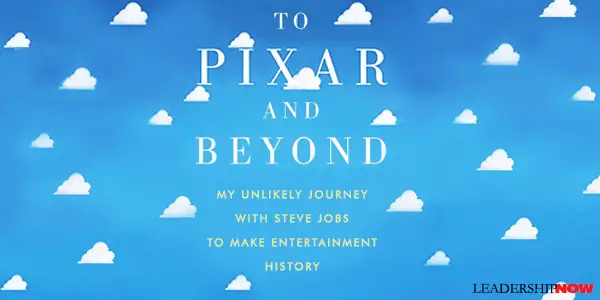
FROM A PICTURE IN A MAGAZINE, Lawrence Levy was asked by Steve Jobs to become the CFO of Pixar and structure it in a way that investors could understand it. The trick was to preserve whatever it was about Pixar that enabled great stories to happen in the process. And he captures well how that was done.
While the nuts and bolts of this story has been told before, Levy creates from his perspective, a very readable account by weaving his own growth along the way. To Pixar and Beyond: My Unlikely Journey with Steve Jobs to Make Entertainment History is a personal story. It's hard to put down. Here are some of the key takeaways:
 There’s nothing you can do about where the pieces are. It’s only your next move that matters. There’s nothing you can do about where the pieces are. It’s only your next move that matters.
 Corporations are like living creatures. They have personalities, emotions, and habits. The person at the top might seem to be calling all the shots but is often imprisoned in a culture he or she can do little to change. s corporations, succeed, they generally become more conservative. The flames of creativity on which a company is built can easily cool as pressures to perform mount. Success brings something to defend, something to lose. Fear can easily trump courage. Corporations are like living creatures. They have personalities, emotions, and habits. The person at the top might seem to be calling all the shots but is often imprisoned in a culture he or she can do little to change. s corporations, succeed, they generally become more conservative. The flames of creativity on which a company is built can easily cool as pressures to perform mount. Success brings something to defend, something to lose. Fear can easily trump courage.
 I felt really proud of our decision [to give control to the creative team and not the executive team]. We had chosen to truly empower talent, to send a signal to Pixar’s creative leaders that we trusted them. I cannot say this approach would be right for every company. But I can say that whether you’re making bottled water, mobile games, or computer chips, the decision of who has control over the creative elements is among the most important any team will make. Fear and ego conspire to rein in creativity, and it is easy to allow creative inspiration to take a back seat to safety. It is one thing to cite the adage “Story is king.” It is another thing entirely to live by it. I felt really proud of our decision [to give control to the creative team and not the executive team]. We had chosen to truly empower talent, to send a signal to Pixar’s creative leaders that we trusted them. I cannot say this approach would be right for every company. But I can say that whether you’re making bottled water, mobile games, or computer chips, the decision of who has control over the creative elements is among the most important any team will make. Fear and ego conspire to rein in creativity, and it is easy to allow creative inspiration to take a back seat to safety. It is one thing to cite the adage “Story is king.” It is another thing entirely to live by it.
 The natural tendency in negotiation is to engage in positional bargaining. This means taking a position knowing that it is not a final position, and holding in reserve a backup position. The danger of positional bargaining is that it forces you to think about backup positions, which weakens your conviction in your original position. It’s like negotiating against yourself. Plan A may be your optimal outcome, but inwardly you have already convinced yourself to settle on Plan B. The natural tendency in negotiation is to engage in positional bargaining. This means taking a position knowing that it is not a final position, and holding in reserve a backup position. The danger of positional bargaining is that it forces you to think about backup positions, which weakens your conviction in your original position. It’s like negotiating against yourself. Plan A may be your optimal outcome, but inwardly you have already convinced yourself to settle on Plan B.
Both Steve and I had a strong distaste for approaching negotiations this way. We preferred to develop our positions without thinking through a backup… Once Steve decided what he wanted in a negotiation, he developed something akin to a religious conviction about it. In his mind, if he didn’t get what he wanted, nothing else would take its place, so he’d walk away…. The risk, however, was in so overreaching that we would end up with nothing. If we were not going to have a backup plan, we had to be very careful about knowing what we wanted.
 We can build extraordinary organizations that foster creativity, dignity, and humanity while respecting business disciplines. We just have to be tuned to it; we have to be willing to balance bureaucracy with the depth and subtlety of creative inspiration, and awareness of the human dimension of our endeavors. We can build extraordinary organizations that foster creativity, dignity, and humanity while respecting business disciplines. We just have to be tuned to it; we have to be willing to balance bureaucracy with the depth and subtlety of creative inspiration, and awareness of the human dimension of our endeavors.
We humans do better when we have something to ground us, a deep source from which we can draw wisdom, insight, and inspiration. The goal of that source is to empower us, to bring depth and fulfillment to our lives, to give us the means to soar.
* * *  Like us on Instagram and Facebook for additional leadership and personal development ideas.
* * *


 
Posted by Michael McKinney at 08:36 AM
Permalink
| Comments (0)
| Five Lessons
02.22.16

5 Leadership Lessons: What if the Rules to Winning Were Different than You Thought?
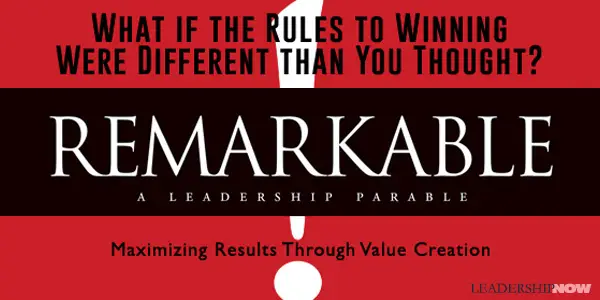
WHAT IF GIVING VALUE beat extracting value every time? What is seeing others succeed was the greatest reward?
It is a Remarkable! culture that does that every time.
A Remarkable! culture is one where people believe the best in one another, want the best for one another, and expect the best from one another.
In this business fable— Remarkable!—authors Randy Ross and David Salyers present how to build a workplace culture that inspires your team members to bring the best of who they are to the table every day, creating an environment that maximizes value creation in every endeavor. It requires shifting into “growth gear.” Importantly, they point out that if we want something to change, we need to add fresh oil—humility. “Where there is defensiveness and resistance, people pull away from one another and erect emotional barriers. When authenticity and humility are present, unity is often the result.”
 If you have an engagement problem, then you have a clutch problem. The clutch is the mechanism that provides for the engagement of two or more components to produce motion. A clutch situation is any encounter that requires the engagement of two or more people to create progress. The clutch, as you well know, provides the linkage between the engine and the transmission, which ultimately provides power to the drive shaft. When the clutch is engaged, the power produced by the engine is harnesses and transferred to the drive shaft to produce motion. If the clutch is disengaged, then the engine continues to produce power, but it’s uncoupled from the drive shaft, rendering it incapable of turning wheels and garnering traction. You literally cannot “get things into gear” when the clutch is malfunctioning. If you have an engagement problem, then you have a clutch problem. The clutch is the mechanism that provides for the engagement of two or more components to produce motion. A clutch situation is any encounter that requires the engagement of two or more people to create progress. The clutch, as you well know, provides the linkage between the engine and the transmission, which ultimately provides power to the drive shaft. When the clutch is engaged, the power produced by the engine is harnesses and transferred to the drive shaft to produce motion. If the clutch is disengaged, then the engine continues to produce power, but it’s uncoupled from the drive shaft, rendering it incapable of turning wheels and garnering traction. You literally cannot “get things into gear” when the clutch is malfunctioning.
 As human beings we are designed to create value in life. There are essentially two approaches to life: one seeks to extract value from every endeavor, and the other seeks to create and bring value to every endeavor. We want our presence to make a positive difference. We want to be appreciated and affirmed for our work. We want to leave a lasting legacy. But this desire to bring value can often become twisted into a drive to achieve. Some people think life is defined and measured by pay scale and material possessions. But that’s a perversion of a natural longing for significance that comes through creating value. A sense of satisfaction and significance comes from understanding who you are and how you can best bring value to every relationship and every endeavor in life. As human beings we are designed to create value in life. There are essentially two approaches to life: one seeks to extract value from every endeavor, and the other seeks to create and bring value to every endeavor. We want our presence to make a positive difference. We want to be appreciated and affirmed for our work. We want to leave a lasting legacy. But this desire to bring value can often become twisted into a drive to achieve. Some people think life is defined and measured by pay scale and material possessions. But that’s a perversion of a natural longing for significance that comes through creating value. A sense of satisfaction and significance comes from understanding who you are and how you can best bring value to every relationship and every endeavor in life.
 For any company, a primary consideration should always be, “How do we structure our organization to allow everyone to think and act like owners?” Taking ownership for your actions and seeking to strengthen relationships in everything you do make a world of difference. The emphasis shifts to doing what’s right and what will bring the most value to life. It becomes less about comparison and more about contribution. It becomes less about competition and more about collaboration. For any company, a primary consideration should always be, “How do we structure our organization to allow everyone to think and act like owners?” Taking ownership for your actions and seeking to strengthen relationships in everything you do make a world of difference. The emphasis shifts to doing what’s right and what will bring the most value to life. It becomes less about comparison and more about contribution. It becomes less about competition and more about collaboration.
 To move out of a focus on the self you must focus on bringing the greatest value to everyone whom the decision may impact. Such a decision-making process is others-focused. Also, we must focus on long-term value generation versus the immediate benefits of any decision. The clutch question is what is the superior choice? The superior choice is always the one that creates the greatest value. To move out of a focus on the self you must focus on bringing the greatest value to everyone whom the decision may impact. Such a decision-making process is others-focused. Also, we must focus on long-term value generation versus the immediate benefits of any decision. The clutch question is what is the superior choice? The superior choice is always the one that creates the greatest value.
 What we need to do to reach our full potential is allow our values to drive our business. We need to define, articulate, and embody our values. When I say “values,” I’m referring to how people evaluate certain aspects of the world around them. Values are shaped by how much importance an individual places on certain elements in a decision-making process. [For instance, if you have to make a choice between safety and timeliness, your decision shows what you place more value on.] The problem is that many companies do not clarify what is of greater importance. What we need to do to reach our full potential is allow our values to drive our business. We need to define, articulate, and embody our values. When I say “values,” I’m referring to how people evaluate certain aspects of the world around them. Values are shaped by how much importance an individual places on certain elements in a decision-making process. [For instance, if you have to make a choice between safety and timeliness, your decision shows what you place more value on.] The problem is that many companies do not clarify what is of greater importance.
* * *  Like us on Instagram and Facebook for additional leadership and personal development ideas.
* * *


 
Posted by Michael McKinney at 12:56 AM
Permalink
| Comments (0)
| Five Lessons
12.17.14

5 Leadership Lessons: Richard Branson on Leadership
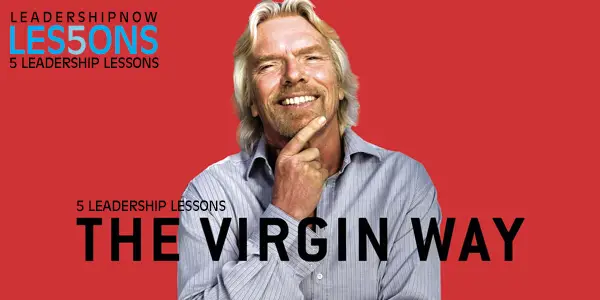
The Virgin Way by Richard Branson takes us over very familiar territory. But then maybe that’s the point.
While there is not much that is new, Branson has taken sound principles and demonstrated that – in practice – they work. He quotes Mark Twain, “All ideas are second-hand, consciously and unconsciously drawn from a million outside sources, and daily used by the garnerer with a pride and satisfaction born of the superstition that he originated them.” And indeed they are. Our problem is age-old: putting what we know into practice.
Bottom-line: There is no secret sauce.
Anyone who puts themselves out there will attract more naysayers than usual. Branson is no exception. His book is enjoyable to read, but it would have been more helpful to provide more nuts-and-bolts of his entrepreneurial adventures—the man behind the hype.
 One of the keys to “the way” we do things is nothing more complex than listening – listening intently to everyone who has an opinion to share, not just the self-professed experts. It’s also about learning from each other, from the marketplace and from the mistakes that must be made in order to get anywhere that is original and disruptive. One of the keys to “the way” we do things is nothing more complex than listening – listening intently to everyone who has an opinion to share, not just the self-professed experts. It’s also about learning from each other, from the marketplace and from the mistakes that must be made in order to get anywhere that is original and disruptive.
 Any culture with an over-emphasis on “knowing your position” creates problems that get in the way of relationships, causes resentment and, as a direct result of this, can interfere with progress and innovation. Any culture with an over-emphasis on “knowing your position” creates problems that get in the way of relationships, causes resentment and, as a direct result of this, can interfere with progress and innovation.
 Don’t waste your time and energy trying to light a fire under flame-resistant people. If that basic, smoldering fire is not innate then no amount of stoking is ever going to ignite it. The exact same principle applies to positive attitudes in people – you don’t train attitudes, you have to hire them. (We now hire for attitude and not paper qualifications.) Don’t waste your time and energy trying to light a fire under flame-resistant people. If that basic, smoldering fire is not innate then no amount of stoking is ever going to ignite it. The exact same principle applies to positive attitudes in people – you don’t train attitudes, you have to hire them. (We now hire for attitude and not paper qualifications.)
 To achieve lasting progress we must identify, nurture and learn from the next generation of business leaders. The leaders of tomorrow will be so much more effective if they are taught to retain and refine that childlike curiosity for the unknown, rather than having it “schooled” out of them, as seems still to be the case today in so many schools and universities. To achieve lasting progress we must identify, nurture and learn from the next generation of business leaders. The leaders of tomorrow will be so much more effective if they are taught to retain and refine that childlike curiosity for the unknown, rather than having it “schooled” out of them, as seems still to be the case today in so many schools and universities.
 Going it alone is an admirable but foolhardy and highly flawed approach to taking on the world. So please, take it from me: no matter how incredibly smart you think you are, or how brilliant, disruptive or plain off-the-wall your new concept might be, every start-up team needs at least one good mentor. Someone, somewhere, has already been through what you are convinced nobody else has ever confronted! Going it alone is an admirable but foolhardy and highly flawed approach to taking on the world. So please, take it from me: no matter how incredibly smart you think you are, or how brilliant, disruptive or plain off-the-wall your new concept might be, every start-up team needs at least one good mentor. Someone, somewhere, has already been through what you are convinced nobody else has ever confronted!
* * *  Like us on Instagram and Facebook for additional leadership and personal development ideas.
* * *

Posted by Michael McKinney at 11:02 PM
Permalink
| Comments (0)
| Five Lessons
09.22.14

5 Leadership Lessons: How Google Works

How Google Works by Eric Schmidt and Jonathan Rosenberg is how Google created its innovative and productive culture.
The book is full of principles that if they can’t be implemented outright in your own workplace, they can by degrees. You won’t find debates about social issues, but then that’s not what this book is about. It’s about how Google goes about doing what it does do—day to day. It about managing smart creatives in a family-type atmosphere.
 Offices should be designed to maximize energy and interactions, not for isolation and status. Smart creatives thrive on interacting with each other. The mixture you get when you cram them together is combustible, so a top priority must be to keep them crowded. Offices should be designed to maximize energy and interactions, not for isolation and status. Smart creatives thrive on interacting with each other. The mixture you get when you cram them together is combustible, so a top priority must be to keep them crowded.
 Don’t listen to the HiPPOs. The Highest-Paid-Person’s-Opinion. When it comes to the quality of decision-making, the pay level is intrinsically irrelevant and experience is valuable only if it is used to frame a winning argument. Unfortunately, in most companies, experience is the winning argument. We call these places “tenurocracies,” because power derives from tenure, not merit. It reminds us of our favorite quote from Jim Barksdale, erstwhile CEO of Netscape: “If we have data, let’s look at data. If all we have are opinions, let’s go with mine.” Don’t listen to the HiPPOs. The Highest-Paid-Person’s-Opinion. When it comes to the quality of decision-making, the pay level is intrinsically irrelevant and experience is valuable only if it is used to frame a winning argument. Unfortunately, in most companies, experience is the winning argument. We call these places “tenurocracies,” because power derives from tenure, not merit. It reminds us of our favorite quote from Jim Barksdale, erstwhile CEO of Netscape: “If we have data, let’s look at data. If all we have are opinions, let’s go with mine.”
 One of our early engineers, Matt Cutts, recall how he would often see Urs Hölzle, the engineering executive who led the creation of Google’s data center infrastructure, pick up small bits of trash in the hallway as he walked through the office. With these actions, the leaders demonstrate their egalitarian natures—we’re all in this together and none of us are above the menial tasks that need to get done. Mostly, though, they do it because they care so much about the company. Leadership requires passion. If you don’t have it, get out now. One of our early engineers, Matt Cutts, recall how he would often see Urs Hölzle, the engineering executive who led the creation of Google’s data center infrastructure, pick up small bits of trash in the hallway as he walked through the office. With these actions, the leaders demonstrate their egalitarian natures—we’re all in this together and none of us are above the menial tasks that need to get done. Mostly, though, they do it because they care so much about the company. Leadership requires passion. If you don’t have it, get out now.
 Our ideal candidates are the ones who prefer roller coasters, the ones who keep learning. These “learning animals” have the smarts to handle massive change and the character to love it. Most people, when they are hiring for a role, look for people who have excelled in that role before. This is not how you find a learning animal. Favoring specialization over intelligence is exactly wrong, especially in high tech. The world is changing so fast across every industry and endeavor that it’s a given the role for which you’re hiring is going to change. Our ideal candidates are the ones who prefer roller coasters, the ones who keep learning. These “learning animals” have the smarts to handle massive change and the character to love it. Most people, when they are hiring for a role, look for people who have excelled in that role before. This is not how you find a learning animal. Favoring specialization over intelligence is exactly wrong, especially in high tech. The world is changing so fast across every industry and endeavor that it’s a given the role for which you’re hiring is going to change.
 Google[x] has a simple Venn diagram that it uses to determine if it will pursue an idea. First, the idea has to be something that addresses a big challenge or opportunity, something that affects hundreds of millions or billions of people. Second, they have to have an idea for a solution that is radically different from anything currently in the market. We aren’t trying to improve on an existing way of doing something, rather we want to start over. And third, the breakthrough technologies that could bring that radical solution to life have to be at least feasible, and achievable in the not-too-distant future. Before the [x] team starts pursuing any idea, it first checks to see if the idea fits into this three-part paradigm. If it doesn’t, it is rejected. Google[x] has a simple Venn diagram that it uses to determine if it will pursue an idea. First, the idea has to be something that addresses a big challenge or opportunity, something that affects hundreds of millions or billions of people. Second, they have to have an idea for a solution that is radically different from anything currently in the market. We aren’t trying to improve on an existing way of doing something, rather we want to start over. And third, the breakthrough technologies that could bring that radical solution to life have to be at least feasible, and achievable in the not-too-distant future. Before the [x] team starts pursuing any idea, it first checks to see if the idea fits into this three-part paradigm. If it doesn’t, it is rejected.
 There’s a lot more on communication (You need to say something twenty times, but if you do and they still don’t get it, then the problem is with the theme, not the communications), competition (“If you focus on your competition, you will never deliver anything truly innovative”) and hiring (“Great talent often doesn’t look and act like you”), including ten or so pages on Google’s hiring dos and don’ts and career advice.
* * *  Like us on Instagram and Facebook for additional leadership and personal development ideas.
* * *


 
Posted by Michael McKinney at 11:29 PM
Permalink
| Comments (0)
| Five Lessons
08.14.14

5 Leadership Lessons: Opportunity and Risk are Soul Mates
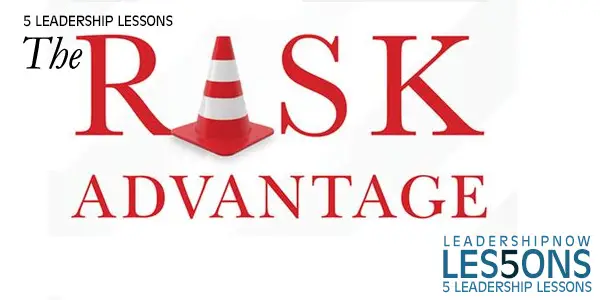
The Risk Advantage by Tom Panaggio is designed as a guide for those who are contemplating an entrepreneurial pursuit, are already engaged in building a business, or are currently working for someone else and want to inject their entrepreneurial ideas and attitude. “Those who understand where risk belongs in their lives,” says Panaggio, “will ultimately be successful.”
 When failure occurs, it’s natural to say, “We made a bad decision.” But what you need to do is ask yourself this question: Was it a bad decision or simply a bad outcome? A decision is a choice you make. Without the benefit of clairvoyance, you base that choice on timely information. It would be unfortunate to measure the decision’s value based solely on outcomes. If we only accept the value of favorable outcomes, then we limit our ability to take risks, and forward progress stops. When failure occurs, it’s natural to say, “We made a bad decision.” But what you need to do is ask yourself this question: Was it a bad decision or simply a bad outcome? A decision is a choice you make. Without the benefit of clairvoyance, you base that choice on timely information. It would be unfortunate to measure the decision’s value based solely on outcomes. If we only accept the value of favorable outcomes, then we limit our ability to take risks, and forward progress stops.
The reality is that important decisions made by intelligent people having the best information and intentions could still result in an undesirable outcome. Leaders make decisions to determine the company’s direction. Promoting the proactive nature of decision-making is the objective because in an environment where there is decision paralysis, forward motion ceases, and that is a bad outcome.
 Go for clarity, not certainty. The idea of clarity pertains more to the direction you want your business to be moving rather than the degree of detail and the language you use. Go for clarity, not certainty. The idea of clarity pertains more to the direction you want your business to be moving rather than the degree of detail and the language you use.
 I have heard all the “If I had” excuses over the years. Unfortunately, this way of thinking is based on false reality, because the road to success is through action, not tools or accessories. While tools, technology, and accessories might be helpful, they do not guarantee success. Effort guarantees success—you have to keep your foot on the accelerator longer and more often than your competitor. I have heard all the “If I had” excuses over the years. Unfortunately, this way of thinking is based on false reality, because the road to success is through action, not tools or accessories. While tools, technology, and accessories might be helpful, they do not guarantee success. Effort guarantees success—you have to keep your foot on the accelerator longer and more often than your competitor.
 Opportunities are not only an advantageous circumstance but also chances to correct, rectify, or prioritize a situation that needs attention. Besides forgoing an opportunity for success because we are waiting for ideal conditions, many business leaders fail to solve problems or correct mistakes because, in their minds, the timing wasn’t right. Opportunities are not one-time occurrences; they are continuous events that present themselves throughout our entire journey. Opportunities are not only an advantageous circumstance but also chances to correct, rectify, or prioritize a situation that needs attention. Besides forgoing an opportunity for success because we are waiting for ideal conditions, many business leaders fail to solve problems or correct mistakes because, in their minds, the timing wasn’t right. Opportunities are not one-time occurrences; they are continuous events that present themselves throughout our entire journey.
 Hoping that something will change to improve your situation will result in defeat, the end of your dream. As a leader, your example of enthusiastically seeking opportunity to execute, improve and deliver results will be the beacon that guides all who follow you. Hoping that something will change to improve your situation will result in defeat, the end of your dream. As a leader, your example of enthusiastically seeking opportunity to execute, improve and deliver results will be the beacon that guides all who follow you.
* * *  Follow us on Instagram and Twitter for additional leadership and personal development ideas.
* * *

Posted by Michael McKinney at 08:52 PM
Permalink
| Comments (0)
| Change
, Five Lessons
01.08.14

5 Leadership Lessons: Amplified Leadership

Amplified Leadership by Dan Reiland is about developing leaders. While it is written with a church audience in mind, the principles and values work in other areas as well. It deserves a wider audience. He places the development of leaders into a five-step process: Establish a Relationship, Engage a Follower, Embrace a Team, Coach an Apprentice, and finally, Mentor a New Leader. Here are five lessons from his book:
 Leaders with character do not set themselves above the people. They roll up their sleeves, get involved, and show the way. Those of us who are leaders are the models, the ones people look to as examples. So we must live in a way that is worthy of the high calling of leadership. Leaders with character do not set themselves above the people. They roll up their sleeves, get involved, and show the way. Those of us who are leaders are the models, the ones people look to as examples. So we must live in a way that is worthy of the high calling of leadership.
 It is often said that true community requires authenticity. But it’s also true that you can’t express authenticity outside of community. Authenticity requires healthy relationships. As a leader, you need a small group of friends, perhaps three to five, who give you absolute permission to be yourself at all times. If you get “off track” in some way, someone in the group will be there to let you know. This increases your ability to be self-aware and improves your comfort level with your true self. This honest and healthy feedback from your circle of friends will give you the confidence to express yourself without fear when you are in less familiar territory—a place leaders know all too well. It is often said that true community requires authenticity. But it’s also true that you can’t express authenticity outside of community. Authenticity requires healthy relationships. As a leader, you need a small group of friends, perhaps three to five, who give you absolute permission to be yourself at all times. If you get “off track” in some way, someone in the group will be there to let you know. This increases your ability to be self-aware and improves your comfort level with your true self. This honest and healthy feedback from your circle of friends will give you the confidence to express yourself without fear when you are in less familiar territory—a place leaders know all too well.
 Great partnerships have a way of purifying leaders’ motives. To make a partnership work, leaders must set their agendas aside (not the vision, but any personal agendas). Wise leaders remain open to new ways of doing things and are gracious enough to accept that things will not always go their way. This is what you have to give up to go up. If you let other strong leaders on the team, they will have differing opinions. And if they are putting great ideas on the table, you would be wise to consider them. You won’t always get the credit or public attention when you participate in a partnership. But receiving credit should not be your goal. In fact, I hope your ministry develops such a strong culture of giving credit away that it becomes second nature for your team members to celebrate other leaders’ contributions over their own. Great partnerships have a way of purifying leaders’ motives. To make a partnership work, leaders must set their agendas aside (not the vision, but any personal agendas). Wise leaders remain open to new ways of doing things and are gracious enough to accept that things will not always go their way. This is what you have to give up to go up. If you let other strong leaders on the team, they will have differing opinions. And if they are putting great ideas on the table, you would be wise to consider them. You won’t always get the credit or public attention when you participate in a partnership. But receiving credit should not be your goal. In fact, I hope your ministry develops such a strong culture of giving credit away that it becomes second nature for your team members to celebrate other leaders’ contributions over their own.
 I’m passionate about mentoring others. That’s what good leaders do. They teach others how to lead. It doesn’t matter if you mentor ten leaders or hundreds in your lifetime. What matters is that you mentor someone. Are you investing in any new leaders? If so, how are you making a difference in their lives? Will someone lead better because of you? I’m passionate about mentoring others. That’s what good leaders do. They teach others how to lead. It doesn’t matter if you mentor ten leaders or hundreds in your lifetime. What matters is that you mentor someone. Are you investing in any new leaders? If so, how are you making a difference in their lives? Will someone lead better because of you?
 Leaders who are good at developing others make an intentional effort to keep improving personally. They keep the fire inside hot. You may have years of experience and be well beyond the level of the person you are mentoring, but eventually, you will have little to offer if you stop growing as a leader. If you don’t keep the fires hot, your “leadership balloon” is going to come down. Do you reinvent yourself? Reinventing yourself is about staying out of a comfort zone. Any leader can fall into this place of comfort if he is not growing, stretching, learning, and changing. It is lethal to a leader when everything is balanced, stable, known, and in pleasant symmetry. Leaders who are good at developing others make an intentional effort to keep improving personally. They keep the fire inside hot. You may have years of experience and be well beyond the level of the person you are mentoring, but eventually, you will have little to offer if you stop growing as a leader. If you don’t keep the fires hot, your “leadership balloon” is going to come down. Do you reinvent yourself? Reinventing yourself is about staying out of a comfort zone. Any leader can fall into this place of comfort if he is not growing, stretching, learning, and changing. It is lethal to a leader when everything is balanced, stable, known, and in pleasant symmetry.
* * *All of these lessons underscore the need for a leader to be able to develop and maintain good relationships. Not only is leadership about relationships, but the ability to maintain good relationships helps to draw a leader outside of themselves and consider the needs and gifts of others. If we are not surrounded by good relationships our leadership quickly narrows down to and stagnates around our own thoughts. Selfish thoughts then rule our decision making.
* * *  Like us on Instagram and Facebook for additional leadership and personal development ideas.
* * *


 
Posted by Michael McKinney at 01:10 AM
Permalink
| Comments (0)
| Five Lessons
09.02.13

5 Leadership Lessons: It’s Already Inside You
Robert Murray believes that everything you need to be a great leader is already inside you. “It’s in your DNA.” I also agree that many people graduating from our schools today do not have the ability to think critically. “Problem finders are everywhere,” writes Murray. “Innovative problem solvers are rare. Imagination and thinking outside the box is scarce.”
It’s Already Inside (Kindle) is a collection of well-told personal stories with solid leadership lessons. Here are several of the lessons:
 Never walk past corporate graffiti. It comes in all forms. From brand violations to messy office space, from inconsistent customer service to poor employee practices and procedures, and to leadership apathy. It’s your job as a leader to do everything within your power to ensure graffiti is removed immediately when it appears.
 In leadership, you cannot successfully fly by the seat of your pants, or in other words, fake your way through every scenario you come across. You might every once in awhile; however, you cannot on a lasting basis. You need to develop some form of leadership flight simulator that you can immerse yourself in to design the best-case solutions to complex problems. This process will enable you to respond quickly and naturally when something happens and …without stress.
 Survey each person in your business, from the janitor and those in the mailroom to the accountant and HR person. Ask them how their individual roles serve the customer, ask for their ideas to better serve the customer, and ask what they hear about the company on the street from customers. If they are clueless, meet with the employee individually to explain his or her role as salesperson [leader] for the company and to brainstorm ways to enhance it.
 Windows and Mirrors. Your stock as a leader (and leadership stock is measured by how much people trust you and will follow you on a journey) goes up significantly when you practice two simple “leadership optics” habits. Look out the window when times are good and look in the mirror when things aren’t going so well.
 Do not make the mistake of thinking home is the place to go when you are tired of being nice to people. Do not make the mistake of thinking home is the place to go when you are tired of being nice to people. Home is NOT the place to go and vent about everything that frustrates you in your job. Home is NOT the place you go to continue working like a dog doing email and reports. Home, or your personal life, is the reason you go to work, because it is work that finances your personal life. Home is also the place that will be there for you long after the job. The job—the business, you as a leader—is just the means to an end—not the other way around. Understanding this valuable truth is not being disloyal to your organization or your entrepreneurial dreams; it is what will keep you balanced, healthy, and strong to be better at what you do!
* * * Like us on Facebook for additional leadership and personal development ideas.
* * *
Posted by Michael McKinney at 10:47 PM
Permalink
| Comments (0)
| Five Lessons
05.23.13

5 Leadership Lessons: The Manager and the Monk

The Manager and the Monk is one of those books that comes along every now and again, that will shape and inspire your thinking. It is a deeply philosophical book with very practical applications. The book is essentially a conversation between Jochen Zeitz, the former Chairman and CEO of Puma, and Father Anselm Grün, the financial manager of the Münsterschwarzach Abby near Würzburg, Germany. Zeitz is also co-founder and co-chair with Sir Richard Branson of The B Team.
Together Zeitz and Grün discuss important topics like success, culture, values, acting ethically, the environment, commerce, sustainability, strengths and weaknesses and awareness.
The book reflects their concern to think beyond the immediate concerns of business to how decisions could affect other people and the environment around them. "We should always be aware of the effects of our decisions." In the moment, it is often hard to remember that principle. Here are several thoughts from the book:
 On Leadership On Leadership: Even in monasteries, one has the illusion that small communities need no authority and that they can lead themselves. But that's a mistake because where there is no clear structure, informal power structures will develop on their own. Then the most assertive Brother will assume leadership, but if his power is not clearly established, he will only exercise it when doing so benefits him. When he is supposed to assume responsibility for the community, however, he will refuse and draw back so that he has no official leadership role. Such unclear power structures are not good for either the community or a firm.
 On Culture: Regarding culture, in my opinion, the most important leadership goals include integration, an open exchange of ideas, building confidence, and striving for greater equality. A leadership culture also has to be fun, and it must promote meaningfulness and innovation, regardless of how close to the wind you may sail sometimes. On Culture: Regarding culture, in my opinion, the most important leadership goals include integration, an open exchange of ideas, building confidence, and striving for greater equality. A leadership culture also has to be fun, and it must promote meaningfulness and innovation, regardless of how close to the wind you may sail sometimes.
 On Hope: No one can lead a company or corporate group without having hope. Hope is something different from expectation, because the expectation I have for a person or a company can be disappointed. Hoping, on the other hand, means: "I am hoping for you and about you." Hope can never be disappointed, because I will not give up hope that another person will be able to change himself. On Hope: No one can lead a company or corporate group without having hope. Hope is something different from expectation, because the expectation I have for a person or a company can be disappointed. Hoping, on the other hand, means: "I am hoping for you and about you." Hope can never be disappointed, because I will not give up hope that another person will be able to change himself.
 On Acting Ethically: They think that I can solve all problems, that I have always been kindhearted and understanding in dealing with others, and that I am always in harmony with myself. I realize that I must protect myself against such projections, for they are not good for me. They idealize me. If I were to identify myself with these projections, I would become blind to my weaknesses and would come to a standstill. On Acting Ethically: They think that I can solve all problems, that I have always been kindhearted and understanding in dealing with others, and that I am always in harmony with myself. I realize that I must protect myself against such projections, for they are not good for me. They idealize me. If I were to identify myself with these projections, I would become blind to my weaknesses and would come to a standstill.
 On Responsibility: Supervision limits the responsibility of every individual, but as human beings we cannot entirely do without it. Every person can and must have freedom in his work as in his life as a whole, in order to be able to assume responsibility. Every individual needs responsibility, for without it he loses interest and joy in his activities. We say that a person "takes on" responsibility. When we have the feeling that we can assume still more responsibility, then in my opinion we will find the means and ways to do this. On Responsibility: Supervision limits the responsibility of every individual, but as human beings we cannot entirely do without it. Every person can and must have freedom in his work as in his life as a whole, in order to be able to assume responsibility. Every individual needs responsibility, for without it he loses interest and joy in his activities. We say that a person "takes on" responsibility. When we have the feeling that we can assume still more responsibility, then in my opinion we will find the means and ways to do this.
* * *  Follow us on Instagram and Twitter for additional leadership and personal development ideas.
* * *

Posted by Michael McKinney at 08:01 PM
Permalink
| Comments (0)
| Five Lessons
05.14.12

5 Leadership Lessons: The Leader as Strategist
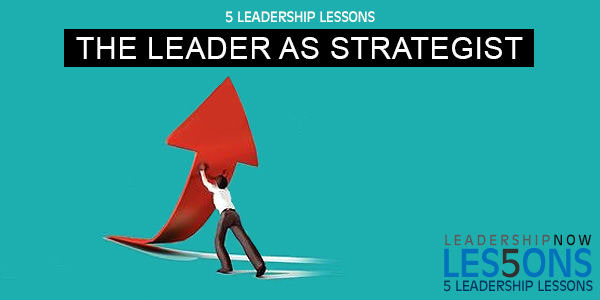
The Strategist is not a book about strategy, but a book designed to equip and inspire you to be a strategist. Author Cynthia Montgomery, says we have reduced strategy to a right-brain exercise and have lost sight of what it takes to lead the effort. The essential component of the strategy-making process is the leader.
Leaders must not ignore or underestimate their crucial and ongoing role as a strategist. “Strategy is not a destination or a solution,” writes Montgomery. “It is not a problem to be solved and settled. It’s a journey. It needs continuous, not intermittent, leadership. It needs a strategist.”
 The myth of the super-manager—that a truly good manager can prevail regardless of the circumstances—is hard to let go. First, you must understand the competitive forces in your industry. How you respond to them is your strategy. Second, even if you understand your industry’s competitive forces, you must find a way to deal with them that is up to the challenge. Third, whatever you do, don’t underestimate the power of those forces. The myth of the super-manager—that a truly good manager can prevail regardless of the circumstances—is hard to let go. First, you must understand the competitive forces in your industry. How you respond to them is your strategy. Second, even if you understand your industry’s competitive forces, you must find a way to deal with them that is up to the challenge. Third, whatever you do, don’t underestimate the power of those forces.
 Strategy is about serving an unmet need, doing something unique or uniquely well for some set of stakeholders. Beating the competition is critical, to be sure, but it’s the result of finding and filling that need, not the goal. Strategy is about serving an unmet need, doing something unique or uniquely well for some set of stakeholders. Beating the competition is critical, to be sure, but it’s the result of finding and filling that need, not the goal.
 Nothing else is more important to the survival and success of a firm than why it exists, and what otherwise unmet needs it intends to fill. Every concept of strategy that has entered the conversation of business managers—sustainable competitive advantage, positioning, differentiation, added value, even the firm effect—flows from purpose. Nothing else is more important to the survival and success of a firm than why it exists, and what otherwise unmet needs it intends to fill. Every concept of strategy that has entered the conversation of business managers—sustainable competitive advantage, positioning, differentiation, added value, even the firm effect—flows from purpose.
 After you’ve identified your purpose, aligned your activities and resources, and tested the results—all internal working steps—you are ready to summarize your strategy in a statement you can use to communicate both inside and outside your firm…. Make every word real. Make every word count. Long sentences and vague language can obscure your effort to describe what’s really important. At best, they’re unhelpful; at worst, they’re potentially misleading and distracting. After you’ve identified your purpose, aligned your activities and resources, and tested the results—all internal working steps—you are ready to summarize your strategy in a statement you can use to communicate both inside and outside your firm…. Make every word real. Make every word count. Long sentences and vague language can obscure your effort to describe what’s really important. At best, they’re unhelpful; at worst, they’re potentially misleading and distracting.
 The most important thing is to understand that you are not a manager of strategy, or a functional specialist. Others can fill those roles. You are, first and foremost, a leader. Your goal is to build something that is not already there. To do so, you must confront the four basic questions you have already explored: The most important thing is to understand that you are not a manager of strategy, or a functional specialist. Others can fill those roles. You are, first and foremost, a leader. Your goal is to build something that is not already there. To do so, you must confront the four basic questions you have already explored:
What does my organization bring to the world?
Does that difference matter?
Is something about it scarce and difficult to imitate?
Are we doing what we need to do in order to matter tomorrow?
As a leader, you must answer them.
* * *  Like us on Instagram and Facebook for additional leadership and personal development ideas.
* * *


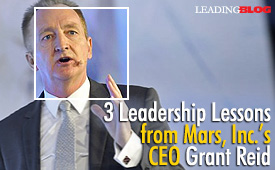 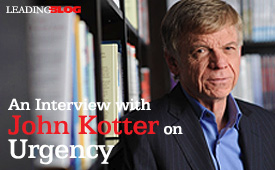
Posted by Michael McKinney at 11:13 PM
Permalink
| Comments (0)
| Five Lessons
, Management
02.20.12

5 Leadership Lessons: Where Negative Emotions Come From
Brian Tracy and Christina Stein have written a book— Kiss That Frog—to help you root out the causes of the negative thoughts that are influencing your attitudes and behaviors more than you realize. It’s a critical issue for leaders.
“All emotions, especially negative emotions, distort evaluations. A person in the grip of a negative emotion is incapable of thinking clearly or rationally.” Here’s the danger: “The more intense the negative emotion, the more the sufferer becomes detached from reality and is incapable of reasoning clearly. The person then talks and acts in a way that is often unexplainable and destructive.”
Tracy and Stein have identified five major factors that cause people to create negative emotions and hold on to them:
 Justification Justification: You defend your negativity and your right to be angry. Negative emotions cannot exist unless you can justify your right to experience them to yourself and others. The more you justify yourself and convince yourself that the other person involved is bad in some way, that you are pure and innocent and are therefore entitled to feel the way you do, the angrier and more upset you become.
 Identification Identification: This means that you take things personally. You interpret what has happened as a personal attack on you. Having healthy emotional boundaries is essential, especially in a work environment. You can be compassionate without identifying with someone else’s emotions.
 Hypersensitivity Hypersensitivity: To be extremely sensitive to the thoughts, opinions, or attitudes of others toward you. Peter Ouspensky called it “inward considering.” In extreme cases, hypersensitive people become paralyzed in that they cannot make a decision without getting the approval of other people.
 Judgmentalism Judgmentalism: The tendency of people to make negative assessments about others. When you judge another, you become emotional. And emotions distort evaluations. People often judge others because they want to control their behavior.
 Rationalization Rationalization: What happens when you put a socially acceptable explanation on an otherwise socially unacceptable act. Because of low self-esteem and weak egos, most people cannot admit that they have done or said something that was not thoroughly reasonable and justified.
Rehashing negative situations allows the negative emotions to grow. Keeping an eye on these factors leading to negative emotions can help you to stop the negative emotion the moment it is triggered.
You have a wonderful mind. But it is a two-edged sword. You can use it to make yourself happy, or you can use it to make yourself angry. Your goal should be to use your intelligence to keep yourself calm, in control, and at peace, no matter what is happening around you or to you.
* * * Like us on Facebook for additional leadership and personal development ideas.
* * *
Posted by Michael McKinney at 10:14 PM
Permalink
| Comments (0)
| Five Lessons
, Personal Development
02.06.12

5 Leadership Lessons: Great Leaders Grow
Ken Blanchard and Mark Miller have penned another business fable, Great Leaders Grow. People and organizations are not fully alive unless they are growing. They ask, “will you be a leader who is always ready to face the next challenge, or will you be a leader that tries to apply yesterday’s solutions to today’s problems? The latter will ultimately fail,” say the authors. The solution is to GROW:
 Growth is the leader’s fountain of youth. Growing, for great leaders, is like breathing. It’s not optional. It is not something you do in addition to your real job. It is at the core of your real job. Your capacity to GROW will determine your capacity to lead. If you get too busy with your job to grow, your influence and your leadership will stagnate and ultimately evaporate.
 I don’t control whether I’ll be in a formal position of leadership. But I can control my readiness to lead.
 My capacity to learn determines my capacity to lead. If I stop learning, I stop leading. If I’m not learning and growing, it will be impossible to leverage my talents.
 Great leaders make the choice to GROW in four areas:
Gain Knowledge. Gain self-knowledge, knowledge of others, your industry, and the field of leadership
Reach Out to Others. You need to be proactive about helping others grow if you’re going to grow and learn. Teaching isn’t just about sharing information, it’s also about helping people draw out new learnings for themselves by the question you ask.
Open Your World. You will add much more value as a leader if you open up and expand your world with leadership experiences and life experiences. Be on the lookout for experiences inside and outside work that will make you a better leader over time.
Walk Toward Wisdom. Growth in wisdom has no formula, but it almost always involves at least one of four elements: rigorous self-evaluation, honest feedback, counsel from others, and time.
 The two primary reasons leaders get off track are ego and fear. For many leaders, their ego is fueled by a heightened sense of confidence—you might call it overconfidence or pride. This, combined with the fear of losing control, often prevents leaders from serving people.
 | | | The path to increased influence, impact, and leadership effectiveness is paved with personal growth.… Our capacity to grow determines our capacity to lead. It’s really that simple, say Blanchard and Miller. The failure to grow sabotages the career of more leaders than anything else. |
|
* * * Like us on Facebook for additional leadership and personal development ideas.
* * *
Posted by Michael McKinney at 09:52 PM
Permalink
| Comments (0)
| Five Lessons
12.20.11

5 Leadership Lessons: What if You Could Take Control of Your Life with One Decision?
 G
GREAT leaders know they cannot let others determine their moods and behaviors. The decision is ours. David Pollay wrote The Law of the Garbage Truck to remind us that “it is not our duty to absorb the frustrations, anxieties, and disappointments of other people. We were not put on earth to carry other people’s negative energy, nor were we created to burden others with ours.” The Law of the Garbage Truck is straightforward:
Many people are like garbage trucks. They run around full of garbage, full of frustration, full of anger, and full of disappointment. As their garbage piles up, they look for a place to dump it. And if you let them, they’ll dump it on you. So when someone wants to dump on you, don’t take it personally. Just smile, wave, wish them well, and move on. Believe me, you’ll be happier.
Here are five lessons from David Pollay, to help us to focus on what really matters personally and professionally:
 The Law of the Garbage Truck is about humility. No one is perfect. You don’t have to defend yourself every time one of your imperfections is pointed out. At the same time there is no need to judge others for their imperfections. If you let garbage trucks unnecessarily activate your defenses at every turn, you’re not following the play. Instead you’re allowing someone to tease you into a battle that’s not yours to fight, thus diverting your energy from the play you’re meant to run. The Law of the Garbage Truck is about humility. No one is perfect. You don’t have to defend yourself every time one of your imperfections is pointed out. At the same time there is no need to judge others for their imperfections. If you let garbage trucks unnecessarily activate your defenses at every turn, you’re not following the play. Instead you’re allowing someone to tease you into a battle that’s not yours to fight, thus diverting your energy from the play you’re meant to run.
 Other people are not the only ones who bring garbage into our lives—we create plenty of our own negativity that stirs memories of our past and makes us fearful of what we imagine awaits us in the future. When negative memories are invoked, we often indulge in looking for new meanings in them. As we engage these bad memories, and as they pass through our consciousness, we strengthen them. We feel the initial mood of disappointment, anxiety, and doubt all over again. By energizing these old memories with new thinking, we give them additional importance in our lives. Other people are not the only ones who bring garbage into our lives—we create plenty of our own negativity that stirs memories of our past and makes us fearful of what we imagine awaits us in the future. When negative memories are invoked, we often indulge in looking for new meanings in them. As we engage these bad memories, and as they pass through our consciousness, we strengthen them. We feel the initial mood of disappointment, anxiety, and doubt all over again. By energizing these old memories with new thinking, we give them additional importance in our lives.
 Many people spend their lives trying to get back at garbage trucks. They feel abused, challenged, or violated after being run over by one, so their mission is to hit back as soon as they can. They often think about what they could have said or should have done and fantasize about revenge. When you center your life on revenge and ruminate about every provocation and slight, you jeopardize everyone’s health, safety, and happiness—including your own. Many people spend their lives trying to get back at garbage trucks. They feel abused, challenged, or violated after being run over by one, so their mission is to hit back as soon as they can. They often think about what they could have said or should have done and fantasize about revenge. When you center your life on revenge and ruminate about every provocation and slight, you jeopardize everyone’s health, safety, and happiness—including your own.
 For the Garbage Trucks in our lives: People who act like Garbage Trucks allow their anger, frustration, insecurity, and disappointment to drown out most everything good around them. Fortunately, people do not act like Garbage Trucks all the time. Eventually they’ll leave the safety of being a Garbage Truck—if even for a moment. They’ll do or say something nice, show concern, or offer their help on some occasion. It’s then that you must recognize their best. Let them know the good you see in them. Show them how much you care and how much they mean to you. When you look for and focus on the good in people, you help them see what is possible in their lives. You give energy to what is right about them. Your love and attention may be what enables them to change. For the Garbage Trucks in our lives: People who act like Garbage Trucks allow their anger, frustration, insecurity, and disappointment to drown out most everything good around them. Fortunately, people do not act like Garbage Trucks all the time. Eventually they’ll leave the safety of being a Garbage Truck—if even for a moment. They’ll do or say something nice, show concern, or offer their help on some occasion. It’s then that you must recognize their best. Let them know the good you see in them. Show them how much you care and how much they mean to you. When you look for and focus on the good in people, you help them see what is possible in their lives. You give energy to what is right about them. Your love and attention may be what enables them to change.
 What about venting? Venting helps people understand your problems. Dumping leaves people feeling burdened by your problems. Venting is based on permission and turns into dumping when you do not have permission to unload your complaints, worries, frustrations, and disappointments on someone. Venting is time sensitive. Dumping, on the other hand, seems to have no end. It starts without consent and suggests that there is no likely solution. You waste people’s time and burden them with your garbage. What about venting? Venting helps people understand your problems. Dumping leaves people feeling burdened by your problems. Venting is based on permission and turns into dumping when you do not have permission to unload your complaints, worries, frustrations, and disappointments on someone. Venting is time sensitive. Dumping, on the other hand, seems to have no end. It starts without consent and suggests that there is no likely solution. You waste people’s time and burden them with your garbage.
* * *  Follow us on Instagram and Twitter for additional leadership and personal development ideas.
* * *

Posted by Michael McKinney at 10:43 PM
Permalink
| Comments (0)
| Five Lessons
, Human Resources
, Management
, Motivation
06.14.11

5 Leadership Lessons: Tim Elmore’s Generation iY

GENERATION iY are the younger Millennials born after 1990. Their world has been defined by technology and shaped by the Internet— iPod, iBook, iPhone, iChat, iMovie, iPad, and iTunes—and for many of them, life is pretty much about "I," says Tim Elmore in Generation iY. “Generation Y is the largest generation in American history and the second half of this generation is different than the first half, measurably different.”
“[H]ere’s something that really saddens me: These kids really do desire to change the world; they just don’t have what it takes to accomplish their lofty dreams,” Elmore writes. “When the work becomes difficult, they change their minds and move on to something else. The new term for them is ‘slactivists’ – they are both slackers and activists.” Elmore argues that we need to change the way we interact with them so that they can grow into adulthood and be the leaders they need to be.
Generation iY is an eye-opening book. It’s backed with research and filled with practical advice. This is an important book for parents and other adults that lead them. Elmore’s thought-provoking analysis will help you to not only rethink your approach in dealing with others but rethink the assumptions that shape your own worldview.

 Generation iY desperately needs mentors. Young people who spend most of their time with peers may drift into a lifestyle that won’t work in the real world. Many are truly lost and need to find their way back to a path that leads to maturity. Generation iY desperately needs mentors. Young people who spend most of their time with peers may drift into a lifestyle that won’t work in the real world. Many are truly lost and need to find their way back to a path that leads to maturity.
 The truth is, not everything is an option in the real world. Sometimes there really is one right answer, only one good choice. Sometimes—quite often, in fact—someone else may decide what we will do, and we must go along with that decision….Sometimes there really is no choice, and kids will be better prepared for adult life if they understand this. The truth is, not everything is an option in the real world. Sometimes there really is one right answer, only one good choice. Sometimes—quite often, in fact—someone else may decide what we will do, and we must go along with that decision….Sometimes there really is no choice, and kids will be better prepared for adult life if they understand this.
 “You’re a winner just because you participated” is a lie we tell our kids and is just as bad as the “gotta be a winner” lie. Winning isn’t everything, but the insistence that “everyone is a winner” has diluted the value of achievement. What “everybody wins” means in reality, is that nobody wins. Kids have nothing to strive for, nothing to feel genuinely proud of. And when they launch into the real world, where there really are winners and losers, kids raised on “everybody wins” may be in for a rude awakening. What will they think when their boss doesn’t reward them for just participating? “You’re a winner just because you participated” is a lie we tell our kids and is just as bad as the “gotta be a winner” lie. Winning isn’t everything, but the insistence that “everyone is a winner” has diluted the value of achievement. What “everybody wins” means in reality, is that nobody wins. Kids have nothing to strive for, nothing to feel genuinely proud of. And when they launch into the real world, where there really are winners and losers, kids raised on “everybody wins” may be in for a rude awakening. What will they think when their boss doesn’t reward them for just participating?
 For many adults, “download” is our default teaching method. We lecture. We direct. We preach. Students today are more geared to learn through uploading. They want to express themselves, and frequently they find out what they believe by hearing themselves talk. They grow through participation. And they’re used to the free flow of information with multiple sources, so they expect to interact with those sources. “Just listening” to a single voice is not only boring to them; increasingly, it doesn’t make sense. For many adults, “download” is our default teaching method. We lecture. We direct. We preach. Students today are more geared to learn through uploading. They want to express themselves, and frequently they find out what they believe by hearing themselves talk. They grow through participation. And they’re used to the free flow of information with multiple sources, so they expect to interact with those sources. “Just listening” to a single voice is not only boring to them; increasingly, it doesn’t make sense.
 Some call this generation the “connecteds.” Instead of using their youthful years to discover who they are and develop a lasting set of values to live by, they may become adults who can’t make it unless they are constantly on Twitter with their friends. Noise. Busyness. Connection. Talk. Volume. Speed. When will they ever unplug and discover their own identity? Will they ever experience the solitude that enables them to think or reflect on their lives? Will they become a generation so connected that they just parrot what peers are saying in their social network? Or will they be individuals who can think and act on their own without consensus from others? Some call this generation the “connecteds.” Instead of using their youthful years to discover who they are and develop a lasting set of values to live by, they may become adults who can’t make it unless they are constantly on Twitter with their friends. Noise. Busyness. Connection. Talk. Volume. Speed. When will they ever unplug and discover their own identity? Will they ever experience the solitude that enables them to think or reflect on their lives? Will they become a generation so connected that they just parrot what peers are saying in their social network? Or will they be individuals who can think and act on their own without consensus from others?
Invest TIME with the next generation. “We must instill in Generation iY,” says Elmore, that “leadership is leveraging my influence for a worthwhile cause.”
* * *  Like us on Instagram and Facebook for additional leadership and personal development ideas.
* * *


 
Posted by Michael McKinney at 10:44 PM
Permalink
| Comments (0)
| TrackBacks (1) | Five Lessons
05.26.11

5 Leadership Lessons: Redesigning Leadership

JOHN MAEDA is the president of the Rhode Island School of Design. In Redesigning Leadership, he—with co-author Becky Bermont—pulls the leadership lessons from the ups and downs of his time there. In his transition from MIT to RISD he found that the two words “free pizza” were a powerful motivator to convene large numbers of students. “Making people work together can be fairly challenging, but getting them to eat together is somehow vastly easier. A meal is often a catalyst for a conversation that can lead to a collaboration, and a meal is a natural happening to signify closure when the collaboration has been completed.”
Leadership is never easy and it is made more difficult by what I perceive is a growing sense of entitlement we all feel in our culture. It’s not all good or bad, but it is something to deal with. Redesigning Leadership is a slim book, but it is full of great thoughts like these:
 Learning something new means finding not just a new way to see the world, but often a new way to change the world. Artists constantly seek to find new and improved means to transform ideas into reality. Learning something new means finding not just a new way to see the world, but often a new way to change the world. Artists constantly seek to find new and improved means to transform ideas into reality.
 Artists rely on their intuition much more than those who are analytically trained. Analytical people tend to take a complex problem and reduce it to its component parts in an effort to solve it step by step. Artists, however, attempt to make giant leaps to a solution, seeming to ignore all constraints. By making those leaps, they sometimes miss the solution completely. But they are not afraid to miss the target. Artists rely on their intuition much more than those who are analytically trained. Analytical people tend to take a complex problem and reduce it to its component parts in an effort to solve it step by step. Artists, however, attempt to make giant leaps to a solution, seeming to ignore all constraints. By making those leaps, they sometimes miss the solution completely. But they are not afraid to miss the target.
 Ironically, with all the communication technologies at our disposal today, it’s still difficult to get a message across to the person sitting right next to you in a reliable fashion. The shortest communication path between two people is a straight talk. Ironically, with all the communication technologies at our disposal today, it’s still difficult to get a message across to the person sitting right next to you in a reliable fashion. The shortest communication path between two people is a straight talk.
 In forming any team, the most basic challenge: getting folks to take the big step away from just being themselves (the thing we all know best) and joining something larger (the thing we fear may let us down). In forming any team, the most basic challenge: getting folks to take the big step away from just being themselves (the thing we all know best) and joining something larger (the thing we fear may let us down).
 Whether brought by duty or desire, once people are in the same room, they’ve assumed the basic stance of being a team—which is to be together. Preconceived negative opinions don’t evaporate, but at least negativity can mix with positivity in the room, which by electrical principles results in the neutralizing of the respective +/- charges. I now consider this the most basic concept to leading a team. Whether brought by duty or desire, once people are in the same room, they’ve assumed the basic stance of being a team—which is to be together. Preconceived negative opinions don’t evaporate, but at least negativity can mix with positivity in the room, which by electrical principles results in the neutralizing of the respective +/- charges. I now consider this the most basic concept to leading a team.
* * *  Follow us on Instagram and Twitter for additional leadership and personal development ideas.
* * *

Posted by Michael McKinney at 09:52 AM
Permalink
| Comments (0)
| Communication
, Creativity & Innovation
, Five Lessons
, Leadership Development
04.22.11

5 Leadership Lessons: What You Need to Know about Developing Teen Leadership

DAN APPLEMAN has written a handbook for developing teen leadership. Based on over 20 years of real world experience, you will find ideas, techniques, examples and even sample statements to guide you. Developing Teen Leadership will not only help you develop leadership skills in yourself and others, but you will find ways to help teens help other teens on their leadership journey.
The challenge for most parents, teachers and teen advisors is first understanding what they believe about leadership. If we think leadership is telling people what to do, it is difficult to guide their understanding of what real leadership is. They learn best by example.
Appleman offers over 50 valuable thoughts that impact your effectiveness with teens. Here are just five:
 Explore options, but leave the decision to them. As a youth advisor, it’s not your job to make things easy on the teens. On the contrary—since people learn from challenges, it is perfectly fine for you to challenge them. One of the best ways to do this is to help them see facets of problems and options that they may not have otherwise considered. Explore options, but leave the decision to them. As a youth advisor, it’s not your job to make things easy on the teens. On the contrary—since people learn from challenges, it is perfectly fine for you to challenge them. One of the best ways to do this is to help them see facets of problems and options that they may not have otherwise considered.
 Listen. The fact that many teens are unwilling to talk to adults is not all, even mostly, their fault. The truth is that most adults are just terrible at listening (both to each other, and to teens and kids). So if you want to have the slightest hope of being heard, your first step is to learn how to listen effectively. Listen. The fact that many teens are unwilling to talk to adults is not all, even mostly, their fault. The truth is that most adults are just terrible at listening (both to each other, and to teens and kids). So if you want to have the slightest hope of being heard, your first step is to learn how to listen effectively.
 Don’t be the boss. When people think about leadership, they often think of authority. It’s easy to confuse the two. While exercising authority is a leadership skill, real leadership does not consist of telling people what to do. [Being bossy will get people to participate,] but that participation will usually be less than enthusiastic. The members of the group will tend to wait for instructions rather than take the initiative. And the boss will spend all their time running around, stressing out, and telling people what to do. Teaching teen leaders the difference between a leader and a boss will be an ongoing task. Don’t be the boss. When people think about leadership, they often think of authority. It’s easy to confuse the two. While exercising authority is a leadership skill, real leadership does not consist of telling people what to do. [Being bossy will get people to participate,] but that participation will usually be less than enthusiastic. The members of the group will tend to wait for instructions rather than take the initiative. And the boss will spend all their time running around, stressing out, and telling people what to do. Teaching teen leaders the difference between a leader and a boss will be an ongoing task.
 Limits. Limits. It is a well-known cliché that kids need limits and even want limits. And setting limits is part of your role. Where most adults go wrong is not on the limit setting—it’s with what happens up until the limits are reached. There is a strong tendency to try to control the activity regardless of where the limit is, and that control goes against the development of leadership among the teens. The real challenge for you is allowing the teens to have complete control over the group as long as that limit is not reached.
 Find ways to say yes. Teens and kids hear the word “no” all the time. It’s no wonder many stop asking. The reality is that teens are generally capable of far more than they are ever expected or allowed to do. Part of teaching leadership is to get teens to realize that they are capable of becoming leaders and accomplishing tasks. One of the best things you can do to encourage this is to, as much as possible, eliminate the word “no” from your vocabulary. Except for health and safety and rules issues, the answer should always be some variation of the word yes. Find ways to say yes. Teens and kids hear the word “no” all the time. It’s no wonder many stop asking. The reality is that teens are generally capable of far more than they are ever expected or allowed to do. Part of teaching leadership is to get teens to realize that they are capable of becoming leaders and accomplishing tasks. One of the best things you can do to encourage this is to, as much as possible, eliminate the word “no” from your vocabulary. Except for health and safety and rules issues, the answer should always be some variation of the word yes.
This is not a book about teens. It is a book about how we as adults relate to teens. Because the only tool we have to teach leadership skills (or anything) to teens is the control we have over our own actions. You can spend hours worrying about what the teens are doing or their attitude, but we can only control the things we do and our own attitude.
—Dan Appleman
* * *  Like us on Instagram and Facebook for additional leadership and personal development ideas.
* * *

Posted by Michael McKinney at 07:10 PM
Permalink
| Comments (0)
| Education
, Five Lessons
, Leadership Development
03.18.11

5 Leadership Lessons: The Velocity Manifesto
In today’s high-velocity environment, Scott Klososky believes you need to understand how to guide your organization in the implementation and usage of technology—in short, how your organization “does” technology.
[As a leader], you—not the IT department, nor the VP of IT, nor the chief information officer (CIO)—must understand, drive and be accountable for how technology is structured in order to reach the strategic goals of the operation….Technology enables velocity—the speed of getting products to market, the speed of delivery, the speed of analytics, and the list goes on. Speed is our friend in almost every case. An organization’s digital plumbing is what facilitates this speed, and it has become the single most important variable for success in many organizations.
The Velocity Manifesto details key actions you must take to gain an advantage in the digital age. He covers three areas: Digital Plumbing (technology infrastructure), High-Beam Strategy (trendspotting), and creating a High-Velocity Culture (integrating different types of skills and lifestyles). Here are five insights from Klososky’s Manifesto:
 We have an amazing ability as a species to solve problems and make improvements. One way to enhance your vision precision is to understand that we will solve the issues in all industries. We will find efficiencies and knock out things that don’t work the way we would like them to. So all you have to do is look at the industry you are in and identify all the things that are wrong with it….Next, you must begin to study how the solution to that problem will impact you, and find out whether you have any ability to solve it on your own.
 The thing you want to be these days is a “fast follower.” The thing you want to be these days is a “fast follower.” The concept here is that you have a better chance of making a good investment in a trend or idea if you are not the very first—but also not the fifth, sixth, or seventh—into the market. Instead, you want to quickly follow the first movers who are trying to capitalize on a blossoming trend.
 In order to play a high-speed game, you need team members who can work at a fast pace—and you also need a team that can work without friction. … Your job as a leader is to create a culture that generates as little friction as possible by leveraging your employee’s strengths and minimizing their differences.
 We have four very different generations in the workforce right now, and another on the way. We have leaders from one generation who can’t relate to the technology sophisticated younger generations, and young people who have a somewhat warped view of what the organization owes them…. Younger generations will not operate like the current generation of leaders….If you want to hire and retain A players, you will have to provide a vibrant culture for Generation Y and the rest of the generations to come.
 Our inventory of technologies is more like a palette of art supplies—it must be formed into technological systems by true artists….By viewing technology construction as an artistic endeavor rather than a mechanical one, we are freed to not only build applications that have a stronger ROI, but also to do a better job of managing IT people. Software engineers, developers, and programmers must be viewed as the artists of this generation.
* * *
Posted by Michael McKinney at 04:54 PM
Permalink
| Comments (0)
| Communication
, Five Lessons
, General Business
, Human Resources
, Vision
01.25.11

5 Leadership Lessons: Five Lessons from Hank Moore
In The Business Tree: Growth Strategies and Tactics for Surviving and Thriving, corporate strategist and author Hank Moore shares some of the lessons he has learned over the years. Here are five:
 You cannot go through life as a carbon copy of someone else. You must establish your own identity, which is a long, exacting process. As you establish a unique identity, others will criticize. Being different, you become a moving target.
 People criticize you because of what you represent, not who you are. It is rarely personal against you. Your success may bring out insecurities within others. You might be what they cannot or are not willing to become.
 If you cannot take the dirtiest job in any company and do it yourself, then you will never become “management.”
 It’s not when you learn. It’s that you learn.
 Achievement is a continuum, but it must be benchmarked and enjoyed along the way.
Moore suggests that you keep your own diary of lessons learned—both reasons for your successes and your failures. What could you add to this list?
* * *
Posted by Michael McKinney at 06:07 PM
Permalink
| Comments (0)
| Five Lessons
12.30.10

5 Leadership Lessons: Artistry Unleashed
I received several requests to explain further the artistry in leadership. In Artistry Unleashed, Hilary Austen has included interviews with business people and professionals concerning their approach to their work. Their comments help to understand the application of qualitative thinking and artistry in the practice in leadership:
 Eric Thomas teaches horsemanship and explains the need for awareness in the moment: “Everybody who rides has the same problem: we’re hoping what we learned yesterday will always apply. You often ride the problem you had a minute ago, or for the goal you want to achieve. But this is not a recipe. It changes every second, and you’ve got to change with it.”
 Scott Cook, Intuit co-founder talks about surrendering to surprise: “I’m a big believer—and this is something I’ve come to learn—in savoring surprises. If there’s something that’s really a big surprise, upside or downside, that’s generally the real world speaking to you, saying there’s something you don’t yet understand.”
 Here are a couple of comments from University of Toronto assistant professor of psychiatry Melanie Carr and could easily apply to leading in the moment—developing artistry in your leadership: “What I love about psychiatry is that it’s a blend of art and science. No matter how much we are able to see patterns and make predictions based on our scientific understanding, no two people are ever exactly the same. So, as a practitioner, your eyes have to remain “fresh.” I like the juxtaposition of pattern recognition and being mindful. People are like a puzzle. There are patterns and there are recurring patterns. But no one is the same. So you can never just pull out one thing and say, ‘I’m going to do this every time.’”
 Gerry Mabin founder of Mabin School in Toronto: “In public schools, the curriculum is constantly pummeled down. And so a teacher has to teach in units. You know, we’re going to do our unit in geometry for a certain number of days, and then move on to the next unit. There’s no revisiting, no integration. It’s all tightly boxed. It’s a killer.” And he adds: “When you’re actually teaching, you’re honing everything; you’re customizing everything. Every question you’re asking, every decision you make, you’re reacting to what’s happening at the moment with the children, whether it’s one child or whether it’s a group of them.”
 To me, this final comment by Hilary Austen applies to the art of leadership and leading in context (situational): “When awareness guides action, the application of skill can leave the realm of mere mechanics. Skill then flows in response to awareness of immediate or anticipated qualities. This means skill works automatically and responsively, rather than in reference to a recipe or a routine.”
Related Interest:
 Leadership: Artistry Unleashed Leadership: Artistry Unleashed
Posted by Michael McKinney at 12:53 AM
Permalink
| Comments (0)
| TrackBacks (1) | Five Lessons
12.16.10

5 Leadership Lessons: Finding the Right Leader
The failure rate of executive transitions—up to 40 percent of all leaders fail in their new roles and are replaced or retired in their first eighteen months on the job—is one of the costliest problems any organization can face.
In The Right Leader, executive career advisor Nat Stoddard and Claire Wyckoff present a process to improve the search for top-level executives. While most selection processes evaluate the candidate’s ability and personality in addition to the company’s needs, they don’t go far enough. Stoddard points out that three other areas need to be considered: the candidates energy and character, and third, the organizations culture. The authors suggest ways to evaluate these additional areas. The thoughts they provide offer lessons for all leaders:
 Recent studies show that executives usually fail because of bad behaviors stemming largely from bad attitudes toward themselves and others rather than from bad judgments, bad strategies, bad plans, or the lack of necessary skill sets.
 A leader’s energy is a very important aspect of who they are; it affects both how they are perceived as well as their ability to endure and preserve against the stress and strain of their responsibilities and the work environment. Their energy level can set the tone for the entire organization.
 Leaders who have been successful in one situation (where their values were closely aligned with those of that organization) will not necessarily be successful in a new situation if their values are not sufficiently aligned with those of the new organization.
 Cultures are neither “good” not “bad”—they simply are. The strength of a culture is the degree to which there is alignment between the values of the organization and those of the individual members.
 The importance of selecting new leaders whose values approximate those of the cultures in which they are embedded is critical because it is the fastest, most assured way to create organizational trust in the leader. Leadership is all about trust. Without trust, leaders become irrelevant functionaries who will fail to accomplish what they have been hired to do—lead.
Posted by Michael McKinney at 11:33 PM
Permalink
| Comments (0)
| Five Lessons
10.25.10

5 Leadership Lessons: Learning to Avoid the Contribution Syndrome
Much of real management wisdom could be summed up in the sentence: “Slow down, and use your head.” In The Management Mythbuster, David Axson writes, “Perhaps the one good thing to emerge from these tumultuous times is that questioning the effectiveness of long-established management practices has gone from being interesting to imperative.” Many of the management practices are outdated says Axson. They are rigid, calendar-based and excessively financial in focus. They can’t keep up the speed of today’s world. We need management practices that function in real time.
He takes to task six traditional management practices that he believes are no longer suited to today’s business world. He argues: Strategic plans are of little use in times of great uncertainty and volatility; Operating plans and budgets provide a false sense of security; Management reporting is driven by an obsolete view of the world; Incentive compensation rewards poor performance and penalizes outstanding performance; Investments in staff education have been inadequate and misdirected; and Technology has failed to improve and in many cases has reduced the effectiveness of management.
In one section he asks, “What makes a successful leader?” From his experience he concludes that the most successful ones share one characteristic— they ask great questions. He observes:
 Great questions are not complex questions; in fact, the best seem blindingly obvious. Unfortunately, a relatively small proportion of people in leadership positions have the courage, confidence, or even the basic common sense to ask the right questions.
 Contribution Syndrome Contribution Syndrome: No matter what the situation, it is the compulsion to contribute; to show how smart you are at every possible opportunity. Our whole merit system is based upon getting the answer “right.” As we move into the business world, contribution syndrome infects our every pore. We must be seen to be contributing in every meeting or on every project. For some, this manifests itself in a complete inability to sit quietly and listen. It seems part of their DNA to feel that if they are not talking, then they are not working.
 As you move up the corporate ladder, a subtle change starts to take place. The best stop talking. They sit quietly, taking in the contributions of everyone else, and limiting their own contribution to asking a few pertinent questions that lead the discussion in a constructive manner.
 The most potent question anyone can ever ask is the simple three-letter inquiry, “Why?” In the world of commerce it is best used in serial repetition. Ask the “why” question at least five times in response to earnest arguments for a particular scheme or plan.
 The key is to keep asking dumb but great questions. This demonstrates a level of humility that is essential for effective leadership. Complexity has become synonymous with sophistication. How do we get better at asking great questions: practice.
Posted by Michael McKinney at 11:14 PM
Permalink
| Comments (0)
| Five Lessons
09.03.10

5 Leadership Lessons: Lessons From Warren Buffett’s Top Business Leaders
In Behind the Berkshire Hathaway Curtain, Ron Chan has interviewed a number of CEOs and executives who have contributed to Berkshire’s Success. Here are some of the insights, philosophies an mindsets from people at the top of their fields:
 Cathy Baron-Tamraz, President and CEO of Business Wire Cathy Baron-Tamraz, President and CEO of Business Wire: “I think a liberal arts education is invaluable in preparing one for the working world. I look at the people I have hired these past 30 years, and to be candid, most of them have had a more general background than a strictly business background.” The whole idea of college is to learn about general principles by taking a variety of courses.
 Randy Watson, President and CEO of Justin Brands Randy Watson, President and CEO of Justin Brands: “I learned that to run a company and be a leader, it is not about the individual, but how the team of people work together to accomplish something for the greater good. It is about working in unison. My job is to make sure that I have the right people in the right place, and then I stay out of their way.”
 Stanford Lipsey, Publisher of the Buffalo News Stanford Lipsey, Publisher of the Buffalo News: “As an advertising executive, I learned to be observant and flexible. I learned to pick up information from my clients so that I could prepare data to attract them. As the saying goes, ‘persistence succeeds when all else fails!’ I just kept trying and trying.”
 Brad Kinstler, President and CEO of See’s Candies Brad Kinstler, President and CEO of See’s Candies: “Spotting talent is more of an art than a science. You’ll never know whether you have an eye for it until you put your managers out in the playing field and observe the way they perform. What I realized is that there is no right or wrong when it comes to picking talent. In fact, you can’t even tell who will be the next leader until he or she becomes one. Leaders come in different shapes and sizes, and it is often during a crisis or other extraordinary situation that their true ability emerges.”
 David Sokol, Chairman of the Board of MidAmerican Energy Holdings Company David Sokol, Chairman of the Board of MidAmerican Energy Holdings Company: “When I was a 27-year-pld project manager, I had to lead some older and more experienced managers. The reality was that some of them were uncomfortable working with me. The only thing I could do was to keep my head down, check my ego at the door, and work extremely hard to prove that I was capable of leading. I didn’t try to convince them of anything other than the need to accomplish everything as a team.
“My father taught me that it is difficult to control others’ perceptions, but I can always control my own actions, and these actions can, over time, alter those perceptions. I constantly show my colleagues that I am an active listener, and I make sure to explain my rationale for every decision and to consider their opinions. That is all I can do, because the reality is that it will soon become clear whether or not I am capable.”
Posted by Michael McKinney at 12:12 AM
Permalink
| Comments (0)
| Five Lessons
, General Business
08.27.10

5 Leadership Lessons: The Wisdom of Bees
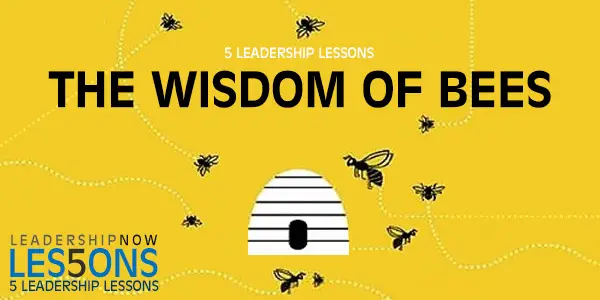
 WHEN talking about wisdom, bees often come up. Aristotle, Marcus Aurelius and Emerson all spoke about bees. And for good reason. They have a lot to teach us. Beekeeper, management consultant and professor, Michael O’Malley, has extracted 25 lessons for leaders in The Wisdom of Bees. Here are five: WHEN talking about wisdom, bees often come up. Aristotle, Marcus Aurelius and Emerson all spoke about bees. And for good reason. They have a lot to teach us. Beekeeper, management consultant and professor, Michael O’Malley, has extracted 25 lessons for leaders in The Wisdom of Bees. Here are five:
 Protect the Future. Bees don’t focus exclusively on the most productive flower patches at any given time, and for good reason. Conditions change rapidly for bees and they can ill afford wide swings in pollen and nectar intake….When a lucrative vein of nectar is discovered, the entire colony doesn’t rush off to mine it no matter how enriching the short-term benefits. The colony has internalized a very important natural rule: someday the nectar in that location will stop flowing and they need to be prepared to rapidly reallocate resources to other productive sites. The best way to ensure that there will be a short run is to focus on the long run….As the bees clearly advise through their behavior, overexploiting a rich patch just because it is there is a death trap. Protect the Future. Bees don’t focus exclusively on the most productive flower patches at any given time, and for good reason. Conditions change rapidly for bees and they can ill afford wide swings in pollen and nectar intake….When a lucrative vein of nectar is discovered, the entire colony doesn’t rush off to mine it no matter how enriching the short-term benefits. The colony has internalized a very important natural rule: someday the nectar in that location will stop flowing and they need to be prepared to rapidly reallocate resources to other productive sites. The best way to ensure that there will be a short run is to focus on the long run….As the bees clearly advise through their behavior, overexploiting a rich patch just because it is there is a death trap.
 Distribute Authority. With many thousands of employed workers, the queen couldn’t possibly direct all of the actions in the field from her command post.…While the queen is the generic heart and soul of the hive, she is by no means the only leader….Those closest to the information should make the relevant decision. Decentralization is one of the hallmarks of the honeybee colony. Foraging decisions, for example, are made by the foragers. The information doesn’t travel up to the queen and back again. If you are thinking of shifting greater power away from the organizational core and into the field, however, consider these facts first: 1) bees have clear objectives; 2) they are excellent communicators and are able to quickly take in and consolidate information—and transform that information into coordinated action; and 3) they are reliable workers that are very good at what they do. Distribute Authority. With many thousands of employed workers, the queen couldn’t possibly direct all of the actions in the field from her command post.…While the queen is the generic heart and soul of the hive, she is by no means the only leader….Those closest to the information should make the relevant decision. Decentralization is one of the hallmarks of the honeybee colony. Foraging decisions, for example, are made by the foragers. The information doesn’t travel up to the queen and back again. If you are thinking of shifting greater power away from the organizational core and into the field, however, consider these facts first: 1) bees have clear objectives; 2) they are excellent communicators and are able to quickly take in and consolidate information—and transform that information into coordinated action; and 3) they are reliable workers that are very good at what they do.

 Order and Innovate Through Fuzzy Constants. Much of the activity of bees is calibrated to constants that allow them to find their way home. When an organization adopts and fastens itself to a few immutable principles, the system as a whole becomes more reliable. A degree of error in the form of initiative, original thinking, and experimentation can then be tolerated. Constants do not drive out originality; they make it possible.…Where several solutions exist in shifting, complex settings, organizations require the intrusion of some variability—but never to the point of disorder. Order and Innovate Through Fuzzy Constants. Much of the activity of bees is calibrated to constants that allow them to find their way home. When an organization adopts and fastens itself to a few immutable principles, the system as a whole becomes more reliable. A degree of error in the form of initiative, original thinking, and experimentation can then be tolerated. Constants do not drive out originality; they make it possible.…Where several solutions exist in shifting, complex settings, organizations require the intrusion of some variability—but never to the point of disorder.
 Keep Your Balance. One of the principle ways that bees moderate extreme behaviors is through genetic diversity….This genetic diversity produces bees within the same hives that are differentially sensitive to environmental conditions. For example, bees keep the temperature of the hive relatively constant at about ninety-three degrees Fahrenheit….The bees heat the hive by contracting two sets of flight muscles and cool the hive by flapping their wings. However, they don’t do this all at the same time….Fortunately, the bees differ in their sensitivity to temperature and alter their behavior at different times in response to climatic conditions….Managers should strive to hire capable people who, as a group, provide the team with a range of perspectives and worldviews. Otherwise, organizations can become closed societies. In addition to making a conscious effort to hire in a fair-minded way, take time to select people who are naturally inquisitive and who have varied interests. Keep Your Balance. One of the principle ways that bees moderate extreme behaviors is through genetic diversity….This genetic diversity produces bees within the same hives that are differentially sensitive to environmental conditions. For example, bees keep the temperature of the hive relatively constant at about ninety-three degrees Fahrenheit….The bees heat the hive by contracting two sets of flight muscles and cool the hive by flapping their wings. However, they don’t do this all at the same time….Fortunately, the bees differ in their sensitivity to temperature and alter their behavior at different times in response to climatic conditions….Managers should strive to hire capable people who, as a group, provide the team with a range of perspectives and worldviews. Otherwise, organizations can become closed societies. In addition to making a conscious effort to hire in a fair-minded way, take time to select people who are naturally inquisitive and who have varied interests.
 Prepare For Leadership Changes. A colony headed by a high-quality queen has a more robust worker population and greater honey yield. It matters a great deal who is at the top. Consequently, it is not surprising that the workers in the hive pay close attention to the queen’s ability to propagate and are sensitive to declines in her performance. The queen’s ability to lead is determined ultimately by the minions, a truth unfortunately lost in many organizations. Leadership depends on the consent of the people to follow. In the instance of bees, the voice of workers is loud and clear….If the honeybee teaches us anything, it is that organizations cannot survive without a leader and, therefore, the colony prevents costly voids in leadership by planning for successors in advance of the obvious need. Colonies die without their top bee; organizations become pathological sans leadership. Prepare For Leadership Changes. A colony headed by a high-quality queen has a more robust worker population and greater honey yield. It matters a great deal who is at the top. Consequently, it is not surprising that the workers in the hive pay close attention to the queen’s ability to propagate and are sensitive to declines in her performance. The queen’s ability to lead is determined ultimately by the minions, a truth unfortunately lost in many organizations. Leadership depends on the consent of the people to follow. In the instance of bees, the voice of workers is loud and clear….If the honeybee teaches us anything, it is that organizations cannot survive without a leader and, therefore, the colony prevents costly voids in leadership by planning for successors in advance of the obvious need. Colonies die without their top bee; organizations become pathological sans leadership.
"As you look for ways to improve your organization,” says O’Malley, “it would not be outlandish to take a step back and ask yourself, What would a bee do?"
* * *  Like us on Instagram and Facebook for additional leadership and personal development ideas.
* * *

 
Posted by Michael McKinney at 09:41 AM
Permalink
| Comments (0)
| Five Lessons
07.16.10

5 Leadership Lessons: Joseph Nye on Leadership
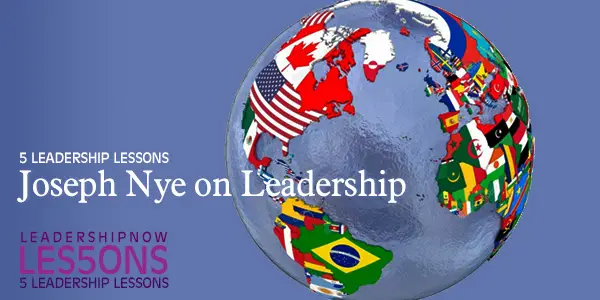
JOSEPH S. NYE is University Distinguished Service Professor at Harvard University's Kennedy School of Government. In The Powers to Lead, he relates leadership and power. He expands further on his concept of soft power—co-opting people rather than coercing them—and hard power—influence involving pressure or threats—but he shows how effective leadership in the real world requires a mixture of both.
Hard and soft power are related because they are both aspects of the ability to achieve one’s purpose by affecting the behavior of others. They sometimes reinforce each other and sometimes they interfere with each other. The use of either one or the other depends on context. The ability to know which to use when is what he calls smart power. We need to know our context.
He says, “Soft power is not good per se, and it is not always better than hard power. Nobody likes to feel manipulated, even by soft power. Like any form of power, it can be wielded for good or bad purposes, and these often vary with the eye of the beholder.”
Here are five leadership lessons from The Powers to Lead:
 Almost anyone can become a leader. Leadership can be learned. It depends on nature and nurture. Leadership can exist at any level, with or without formal authority. Most people are both leader and followers. They “lead from the middle." Almost anyone can become a leader. Leadership can be learned. It depends on nature and nurture. Leadership can exist at any level, with or without formal authority. Most people are both leader and followers. They “lead from the middle."
 Smart leaders need both soft and hard power skills: co-optive and command styles. Both transformational and transactional objectives and styles can be useful. One is not automatically better than the other. Leaders depend on and are partly shaped by followers. Some degree of soft power is necessary. Presence/magnetism is inherent in some personalities more than others, but “charisma” is largely bestowed by followers. Smart leaders need both soft and hard power skills: co-optive and command styles. Both transformational and transactional objectives and styles can be useful. One is not automatically better than the other. Leaders depend on and are partly shaped by followers. Some degree of soft power is necessary. Presence/magnetism is inherent in some personalities more than others, but “charisma” is largely bestowed by followers.
 Appropriate style depends on the context. There are “autocratic situations” and “democratic situations,” normal and crisis conditions, and routine and novel crises. Good diagnosis of the need for change (or not) is essential for contextual intelligence. Appropriate style depends on the context. There are “autocratic situations” and “democratic situations,” normal and crisis conditions, and routine and novel crises. Good diagnosis of the need for change (or not) is essential for contextual intelligence.
 Leadership for crisis conditions requires advance preparation, emotional maturity, and the ability to distinguish the roles of operational, analytical, and political work. The appropriate mix of styles and skills varies with the stage of the crisis. Leadership for crisis conditions requires advance preparation, emotional maturity, and the ability to distinguish the roles of operational, analytical, and political work. The appropriate mix of styles and skills varies with the stage of the crisis.
 The information revolution and democratization are causing a long-term secular shift in the context of postmodern organizations—a shift along the continuum from command to co-optive style. Network organizations require a more consultative style. While sometimes stereotyped as a feminine style, both men and women face this change and need to adapt to it. A consultative style is more costly in terms of time, but it provides more information, creates buy-in, and empowers followers. The information revolution and democratization are causing a long-term secular shift in the context of postmodern organizations—a shift along the continuum from command to co-optive style. Network organizations require a more consultative style. While sometimes stereotyped as a feminine style, both men and women face this change and need to adapt to it. A consultative style is more costly in terms of time, but it provides more information, creates buy-in, and empowers followers.
* * *  Like us on Instagram and Facebook for additional leadership and personal development ideas.
* * *


 
Posted by Michael McKinney at 06:35 PM
Permalink
| Comments (0)
| Five Lessons
, Government
, Leadership
06.08.10

5 Leadership Lessons: Getting Your Leadership in Gear
Rhett Laubach has written a book to help you get your leadership in gear. Leaders in Gear is filled with 37 practical behaviors, strategies and tactics to lead yourself and others and 22 ideas to improve your presentations.
 The best way to have the strength, power and dedication to do all the little things to get and stay into Leader Gear is to put your focus on a greater purpose and mission….This “greater than me” perspective provides fuel when times get tough. Getting into Leader Gear is a daunting task. Staying there is even more demanding. Put and keep your focus on the greater cause, whatever that is for you. It could be your team, customers, core beliefs or faith.
 Big performers don’t see themselves as big performers. They see themselves as growing performers. They are constantly getting better, learning, stretching, risking, pursuing and running. Big performers are in a never-ending battle with complacency.
 Many people don’t grasp the concept of how to create genuine happiness because they are blinded by the hard work it requires and because many times it involves being entirely others-focused.
 Good time managers don’t have to cut corners to meet deadlines. They don’t have to skip breakfast, drive too fast, be short with people, under-deliver on a project, etc. The basic rules of successful living exist, are well-known and are achievable if you manage your time instead of letting your time manage you.
 The Threshold Thread concept states that all high achievers have developed the ability to push their capabilities further than the average person. Their threshold for hard work is higher. Their patience threshold is longer. Their commitment threshold is stronger. Will Smith has been quoted as saying that the true secret to his success is an insane work ethic. He uses running as an example. If you were on a treadmill beside him he knows one thing for certain—you will get off first.
Posted by Michael McKinney at 12:48 PM
Permalink
| Comments (0)
| Five Lessons
04.19.10

5 Leadership Lessons: How to Lead a Fierce Competitor Company
How to be a Fierce Competitor by Jeffrey Fox offers some important reminders for business leaders. Although fierce competitor companies are in a word “flawless,” don’t let that intimidate you from reading this book. Every chapter has valuable, actionable advice. Not surprisingly, Fox has pieced together examples from an assortment of companies (not your run-of-mill examples) to show “what you need to be doing, how you need to be thinking, and the risks you need to take” to be a company that does it right. The advice is directed at leaders, but it shouldn’t be taken to mean exclusively top management. Here are five lessons for leaders at all levels:
 Leaders don’t push others they push themselves. Leaders don’t push others they push themselves. “Great leaders will exhibit levels of confidence that exceeds levels of certainty….They lead the organization with confidence, even when uncertain. They are sometimes fearful but always fearless.” Field Marshall Rommel told his commanders: “Be an example to your men, in your duty and in private life. Let the troops see that you don’t spare yourself in your endurance of fatigue and privation. Always be tactful and well-mannered and teach your subordinates to do the same. Avoid excessive sharpness or harshness of voice, which usually indicates a man who has shortcomings to hide.”
 “Kitchen cabinet” “Kitchen cabinet” is a term from Andrews Jackson’s presidency. He formed an unofficial group of advisors that entered through the back door to maintain their privacy (and value to Jackson). “Leaders need people they can trust. They need people who can and will deliver the unvarnished truth, the organization scuttlebutt, reactions to ideas, solution suggestions. These people may be inside the organization or on the board, but most often they will be outsiders. These people are the leader’s ‘kitchen cabinet.’”
 Keep your hand on the tiller. Keep your hand on the tiller. “Employees know when the captain, the leader, takes his or her hand off the tiller. They sense that the company, like a sailboat, is adrift, off course, in trouble. People in the company will face any storm. Employees are not stupid. They just want to know what they should do. They want to be led. They want certainty of purpose in the people in charge.”
 “ Control what you can control….Roll with that which is beyond your control….When it is raining, the Chinese have a roll-with-it expression: ‘Let it rain.’ You can’t control the rain. So roll with it. Let it rain. But you can control whether or not the company has umbrellas, raincoats, storm water catchment basins, levees.”
 Never Forget the Third Shift. Never Forget the Third Shift. "The 'third shift' is a metaphor for those people and those groups of people who toil in relative anonymity in the organization. They may be the workers on the night shift; the scientists in distant labs, behind locked doors, working on the next breakthroughs; the customer service people dealing with problems and one irate customer after another; the field repair people fixing critical customer machinery on a weekend or holiday; the caregivers that empty bed pans. These people may not be omnipresent, but they are critical to the continuing success of the company. Great managers recognize such people, give them credit, give sincere thank-yous."
Posted by Michael McKinney at 03:50 PM
Permalink
| Comments (0)
| TrackBacks (1) | Five Lessons
03.25.10

5 Leadership Lessons: Colonel Bob Stewart on Leading Under Pressure
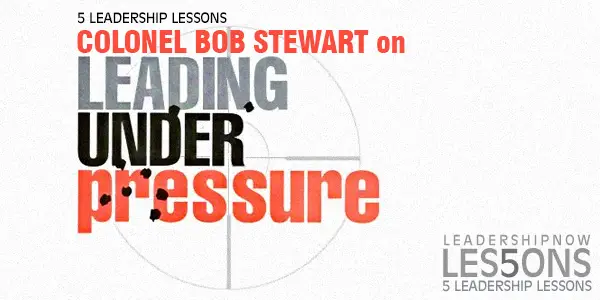
Leadership Under Pressure is a book of lessons learned and shared in personal stories by Colonel Bob Stewart. He was the first British United Nations Commander in Bosnia. On return from Bosnia Stewart was awarded the Distinguished Service Order for “cool courage and inspirational leadership.”
Stewart believes that leadership is universal and is not confined to a few special people. “It is universal, normal and quite ordinary too…. Leading in its basic form is the ability to show the way and guide others to achieve something.” Here are just several of the lessons he presents:
 Leaders make things happen. The reason why people are placed in charge is so that they can make choices that work and make circumstances better. If officers or business executives were to simply follow orders without question and execute a plan according to a set formula, the job could be done by anyone who passes by. What separates officers from soldiers, and business executives from other employees is the fact that both groups are deliberately positioned to determine strategy and then lead others. Leaders make things happen. The reason why people are placed in charge is so that they can make choices that work and make circumstances better. If officers or business executives were to simply follow orders without question and execute a plan according to a set formula, the job could be done by anyone who passes by. What separates officers from soldiers, and business executives from other employees is the fact that both groups are deliberately positioned to determine strategy and then lead others.
 In Bosnia I considered briefing and communication to all members of my battalion to be even more vital than for conventional operations. I put great emphasis on each soldier being able to make his or her own decisions when it was necessary. Repeatedly I told everyone that they were all leaders because whatever they did mattered and would have consequences. Obviously, if soldiers are so empowered, they must know exactly what is planned and their part in it. In Bosnia I considered briefing and communication to all members of my battalion to be even more vital than for conventional operations. I put great emphasis on each soldier being able to make his or her own decisions when it was necessary. Repeatedly I told everyone that they were all leaders because whatever they did mattered and would have consequences. Obviously, if soldiers are so empowered, they must know exactly what is planned and their part in it.
 There is nothing better than personally gained knowledge of what is happening. In both military and commercial life visits are probably the best way of getting up to speed on the reality of what is happening. There is nothing better than personally gained knowledge of what is happening. In both military and commercial life visits are probably the best way of getting up to speed on the reality of what is happening.
 “Look downwards before you look upwards” my father had advised when I arrived at Sandhurst in 1967. His meaning was clear. Care about those who work for you before you concern yourself with pleasing superiors. “Look downwards before you look upwards” my father had advised when I arrived at Sandhurst in 1967. His meaning was clear. Care about those who work for you before you concern yourself with pleasing superiors.
 I find it interesting when organizations opt for anonymous surveys. That worries me a little, even though I understand the good reasons for it. I think my worry is why company leaders feel they will not get the truth without this condition. Surely if company employees feel valued and secure they will also believe that any constructive comments they make will not be misinterpreted and possibly threaten their positions or jobs? I find it interesting when organizations opt for anonymous surveys. That worries me a little, even though I understand the good reasons for it. I think my worry is why company leaders feel they will not get the truth without this condition. Surely if company employees feel valued and secure they will also believe that any constructive comments they make will not be misinterpreted and possibly threaten their positions or jobs?
* * *  Like us on Instagram and Facebook for additional leadership and personal development ideas.
* * *


 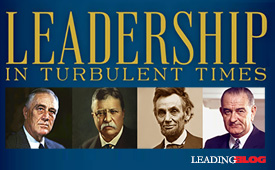
Posted by Michael McKinney at 02:09 PM
Permalink
| Comments (0)
| Communication
, Five Lessons
01.29.10

5 Leadership Lessons: How Men and Women Lead Differently
Men and women are hard-wired to lead each other differently. Understanding that the human brain is hard-wired with its gender, we can use this information to become more gender-intelligent and balanced. Utilizing these differences gives the organization a competitive advantage. In Leadership and the Sexes, Michael Gurian and Barbara Annis reveal these differences:
 In women’s brains, there are more active sensorial and emotive centers, and better linkage of these centers to language centers; men’s senses don’t generally work as well as women’s. Men don’t process as much emotion, and men don’t tend to link as much complex emotion or sensorial detail to words. Men downplay emotion, even at the risk of hurt feelings, in order to play up performance. Men are chemically and neurally directed toward immediate rewards from performance, and they often prod—and sometimes humiliate or shame-coworkers in this direction. Women work constantly toward helping others express emotions in words rather than just in actions and search for a method for direct empathy when someone’s feelings are hurt, even at the expense of current goals.
 In men’s brains, the cerebellum tends to be larger than in the female brain. The cerebellum is the center for action and physical movement. Thus, men tend to communicate more nonverbally, with more emphasis on movement and physicality than women’s emphasis on words. Men also often misread women’s facial expressions of frustration or annoyance—leading women to think that men don’t care. Additionally, men often listen without as much facial expression as women exhibit. Women can tend to feel not heard by men who recline away from them or listen with a blank face.
 Men’s brains enter a “rest state,” a zone out state, more easily than women’s. This happens many times per day naturally for men – comparatively, women’s brains do not shut off in this way except in sleep. Men’s brains also enter a rest state when quantities of words become overwhelming during communication. Men are more likely to “zone out” if discussions become lengthy or wordy. In a meeting, men may keep themselves awake by what might appear to be fidgeting—clicking a pen, tapping, looking away, and the like.
 Men’s brains circulate more testosterone than women’s, as compared to women’s greater neural emphasis on oxytocin. Testosterone is a competition/aggression chemical. Oxytocin is a bonding chemical. Quite often during communication, men will try to compete while women try to bond. The more support women build around them, the lower their stress level.
 Women tend to be more interactive, wanting to keep interactions extended and vital until the interaction has worked through its emotional context. So much more sensory and emotive information is processed through female brain flow that female leaders tend more than men do, to seek more interactions in a day. Men tend to be more transactional in their interactions. Once the transaction of the interaction is complete, they tend to move away from the interaction and back to their more solitary task.
Posted by Michael McKinney at 09:12 AM
Permalink
| Comments (0)
| Five Lessons
10.09.09

5 Leadership Lessons: Fierce Leadership
Fierce Leadership by Susan Scott is a remarkable leadership book for its candor and practicality. She gets to the heart of many relationship issues that prevent us from really connecting with others and limit our performance.
Though the title may seem provocative, the term fierce refers to the type of leadership that engages and connects with people at a deep level. The fierce leaders’ most valuable currency is relationships and emotional capital. Scott writes, “Everywhere, people are hungry to connect, to be seen and known as the unique individuals they are, and this has an immediate and powerful impact on how we design business strategies and market our products and services and ultimately on whether our businesses succeed or fail. Yet much business communication is still stuck in the information age. Too often we treat our conversations and our relationships as we do our e-mails—one way, directive, quick, clipped, efficient.”
Scott suggests another approach to some widely accepted "best practices" moving for instance, from 360 Anonymous Feedback — to 365 Face-to-Face Feedback. The goal here is to have “open, honest, face-to-face conversations, 365 days a year, with the people central to your success and happiness…. When we stay current with one another, our formal performance reviews will contain few, if any, surprises.”
She also suggests a change in emphasis from Hiring for Smarts — to Hiring for Smarts and Emotional Intelligence, from Holding People Accountable — to Modeling Accountability and Holding People Able, from Employee Engagement Programs — to Real Engagement, from Client Centricity — to Client Connectivity, and from Legislated Optimism — to Radical Transparency. The exercises at the end of each chapter are designed to help you implement these ideas in your own leadership role and have been well thought out.
Some leadership lessons:
 A careful conversation is a failed conversation because it merely postpones the conversation that wants and needs to take place.
 What argument am I waging? Are you waging? What are we trying to be right about? The question is not whether our beliefs are right or wrong. We can tell the stories, point to the evidence, build an impressive case. You’re right! Who could possibly argue with the facts? The question is, how are your beliefs working for you?
 John Doerr said, “The moment of truth is when you ask, ‘Are these the people I want to be in trouble with for the next five, ten, fifteen years of my life?’ Because as you build a business, one thing’s for sure: You’ll get in trouble.”
 In meetings, people stubbornly cling to their ideas (sometimes at length!) in an attempt to impress others with the brilliance of their thinking. Their goal is to influence. It does not occur to them that an equally valid goal would be to be influenced, to have their own learning provoked. Nothing new emerges, because individuals are focused on being right rather than on making the best possible decisions for the organization.
 The culture is not some nebulous and mysterious force out there somewhere. You are the culture. I am the culture. And each of us shapes that culture each time we walk into a room, pick up the phone, send an e-mail. Fierce leaders know that they influence the culture one conversation at a time, responding honestly or guardedly when asked what they think.
Posted by Michael McKinney at 12:16 AM
Permalink
| Comments (0)
| TrackBacks (1) | Five Lessons
07.27.09

5 Leadership Lessons: Getting Your Relationships Right
When we think of leadership we naturally regard the objective and view with suspicion the subjective. We value hard data over soft data; reason over instinct; the external world over the internal world. John Townsend writes that “Great leaders succeed by harnessing the power of both the external world and the internal world. You, as a leader, are probably more trained, prepared, and experienced in the external world than you are in the inner one.”
Townsend wrote Leadership Beyond Reason to help you understand and utilize the soft skills – that which is beyond reason. He says “you ignore what is beyond reason at your own peril….Leading from your inner world ultimately produces better results in your leadership.”
He divides our inner world into five areas: values, thoughts, emotions, relationships and transformation. As leadership is about connecting with those you lead and a primary focus of leadership, let’s pull five lessons from Townsend on relationships:
 “You internalize anyone who is significant to you, past and present. As well, the people you are leading are currently internalizing you. As a leader, you have the responsibility of knowing that people are storing mental and emotional pictures of how you relate to and lead them.” These are our relational images. It reminds me of a quote from Shakespeare, “There is a history in all men's lives.” This includes you too. We relate to others in ways that others have related to us. This of course has an impact on the connections we can make with others.
 Develop good and healthy relational images. “Take in the good and forgive and grow from the bad.” He explains, “Some of your own significant relationships may have been with people who were cold, controlling, manipulative, self-centered, critical, or even abusive. This can create distorted or nonfunctioning pictures of how relationships should work.” Is your leadership drawing on images that don’t work for you?
 “An important relational ability for leaders is to see people as separate from you and from their roles with you. Your people want to work with you, or they wouldn’t be with you. But you aren’t their reason for existing. They have lives, dreams, and concerns of their own. You need to be able to identify and understand that. Sometimes leaders assume everyone has the vision as strongly as they do or are as committed as they are. That can be a mistake and can undo what you are trying to accomplish with them.”
 “Relationship provides the bridge over which truth can be conveyed. In your leadership, your people will experience truth in the absence of relationship as harshness, judgment, or condemnation. They will resist it and refuse it, either actively or subtly. Truth is hard to swallow if you don’t feel connected with the truth teller. That is why being “for” the other person, letting them know that, and being as emotionally accessible as possible, at the time of the reality, is critical.” Often “counseling” or performance appraisals derail on this issue as no sense of being “for” the other person has been established. Trying to develop a relationship “at the time of the reality” is too late. Do it now.
 “The better you can relate, the better you will be able to influence and motivate…. Passion is ignited when the real self connects with the right task environment…. You can’t create passion, not for yourself or for anyone else. Your job is to create the right environment for the chemistry to happen. You do this by personal research. You must spend the energy to know your people and learn which tasks intersect with their passions. It will be different for different individuals; it’s not a one-style-fits-all program. But when you develop this relational ability, and get to know the insides of your people, the value and benefits are enormous.
Developing your relational abilities will help you read the landscape. Townsend adds, “The leader who misses relational aspects is surprised when people become distant, resentful, or just leave. The relational leader sees the signs coming a long way away and has time to do something about them.”
Posted by Michael McKinney at 09:51 AM
Permalink
| Comments (0)
| Five Lessons
, Human Resources
, Management
, Motivation
, Positive Leadership
, Teamwork
06.24.09

5 Leadership Lessons: Business Wisdom from Bob Seelert
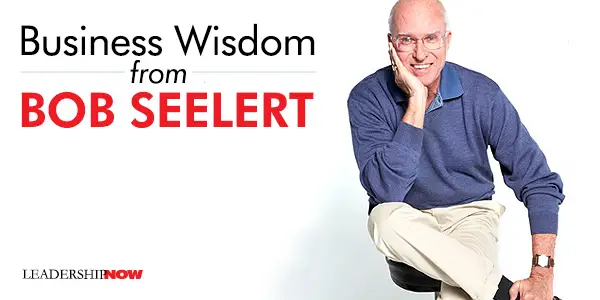 H
HOW do you gain business wisdom—the understanding to “do the right thing, at the right time, for the right reasons”? It is most easily gained by learning vicariously from other people’s experience like from the lessons found in Start with the Answer. Bob Seelert, currently (2019) the non-executive Chairman of the global advertising agency Saatchi & Saatchi, has written a compendium of wisdom gained from over 40 years of wide-ranging experience in the business world.
Seelert says that the most fundamental lesson is that you need to start with the answer in mind and work your way back to the solution. “You have to know where you are going, have the courage to take the first step to get there, and constantly hone the means by which you will reach your destination. Today, too many companies are solution-obsessed and don’t spend enough time up front figuring out the destination, the true answer, and the outcome they are aiming for. You can waste a lot of time and money implementing solutions if you don’t know where you are going.”
 He has organized his lessons into eight categories representing aspects of personal development in business life: preparation, building and managing a career, business strategy, business operations, finance and economics, leadership, culture and communication, and personal spirit and style. From the very practical advice of “Your Clothes are Talking about You” (when in doubt, dress up) to the more subjective perspective of “Evaluating High Performers,” (consider the size of the footprint) anyone in any context will benefit from the 95 down-to-earth experiences and lessons offered here.
Seelert encapsulates each instructive story with a lesson:
 BOB’S WISDOM: Leadership is intangible. The first step is earning the trust of people you work with. Everything else follows from that. BOB’S WISDOM: Leadership is intangible. The first step is earning the trust of people you work with. Everything else follows from that.
 BOB’S WISDOM: Taking the best of the past, and linking it to the present and desired future is the most dynamic way to build a business. BOB’S WISDOM: Taking the best of the past, and linking it to the present and desired future is the most dynamic way to build a business.
 BOB’S WISDOM: Once you’ve identified the company’s best resources, blowing up the old and beginning anew can be the fastest way to put a troublesome past behind you. BOB’S WISDOM: Once you’ve identified the company’s best resources, blowing up the old and beginning anew can be the fastest way to put a troublesome past behind you.
 BOB’S WISDOM: Closing a plant is a sad day, so treat people adversely affected as fairly as possible. Your larger obligation though, is to make the company a great place for the employees who are staying on. BOB’S WISDOM: Closing a plant is a sad day, so treat people adversely affected as fairly as possible. Your larger obligation though, is to make the company a great place for the employees who are staying on.
 BOB’S WISDOM: When a message is important, never be afraid to repeat yourself. People rarely get it the first time around. BOB’S WISDOM: When a message is important, never be afraid to repeat yourself. People rarely get it the first time around.
* * *  Like us on Instagram and Facebook for additional leadership and personal development ideas.
* * *

Posted by Michael McKinney at 01:15 AM
Permalink
| Comments (0)
| Five Lessons
05.13.09

5 Leadership Lessons: Amp Your Team, Rock Your Business
If you were alive in the 70s, you no doubt will remember the band 38 Special (i.e., Caught Up in You and Hold on Loosely). In Jam! by Jeff Carlisi, Dan Lipson and Jay Busbee, 38 Special founding member Carlisi has culled the lessons in teamwork and leadership from his two decades with the band. Businesses and rock bands share a lot of the same issues. “Both require the right mix of marquee names and supporting cast. And both can suffer more from success than they can from failure.”
 Whenever you find yourself part of a new team, Carlisi says you should be asking yourself these questions: What’s my role in this group? What do I bring to the group that no one else can? How am I contributing to (or detracting from) the success of the group? How much responsibility will I have in keeping the group afloat? Which of my teammates can I learn from, and what can I learn?
 Your career will take a downturn. There’s no way around it. So prepare for that downturn by surrounding yourself with the smartest and most effective support team possible. They’ll pick you up when your down and help you find a way out when you’re lost.
 It’s OK to be small but if you’re got bigger dreams, you’ve got to understand what’s necessary to achieve them. We knew we needed a change. We needed to stop following in the footsteps of our forefathers. Everything we were trying to do had already been done by people who were much, much better at it than we were. What’s the point of trying to do something when you’re only 50 or 75 percent as good as the best? Why not break out and be the best in your own field?
 The criticism isn’t the end product; improvement is. The criticism isn’t the end product; improvement is. All too often, criticism is its own end, giving someone a chance to vent frustrations without thinking of the long-term consequences or opportunities. But the idea with criticism is (or at least should be) helping to improve everyone’s game so that the entire team is working at a higher level. “You were terrible!” is useless, damaging criticism. “You were terrible, but here’s what you can do to improve” may not be the most effective approach, but it’s at least got that component of advice. “This could be better, and here’s how,” is a less blaming, more constructive approach.
 Times change and tastes change with them. You’ve got to accept that fact going into any endeavor … so do everything you can to prepare for them. Your work is a large chunk of your identity. And when it goes, a large chunk of your self goes with it. There’s no way to prevent that, but you can start searching around to make connections between what you’ve done before and what you could be doing next. Eventually something will click for you, and when it does, you’ll find it every bit as rewarding as your previous career.
* * *
Related Interest: Sex, Leadership And Rock N' Roll: Leadership Lessons from the Academy of Rock by Peter Cook
Cook cites Sydney Pollack on authenticity:
You go to leadership school, and try to pitch your voice the same way that the boss did there, and have your office decorated the same way his is, and that’s not real leadership. Real leadership probably has more to do with recognizing your own uniqueness than it does with identifying your similarities.
Posted by Michael McKinney at 10:38 PM
Permalink
| Comments (0)
| Five Lessons
, Teamwork
04.23.09

5 Leadership Lessons: Ultimate Leadership - Leading in Context
An important concept in helping you to synthesize all of the leadership material you find is presented in Ultimate Leadership by Russell Palmer. The central idea is that there are basic principles of leadership that all effective leaders apply regardless of their personal leadership style, but they often need to be applied in a very different manner depending on the circumstances and the constituent groups involved.
 Success or failure can often depend on modifying leadership styles to suit a different context.
 General P.X. Kelly: "Listen carefully to the principles of leadership we will teach you here at Quantico, but always apply them within the framework of your own personality. A successful leader never languishes in the comfort of a swivel chair. The most important of all troop-leading steps, yet the one most often neglected, is the last – to supervise. And you supervise by being out with and devoting the bulk of your time to our most important product – people. You can always catch up on what you thought was essential paperwork during the evenings or on weekends, but once neglected, you will find it extremely difficult, if not impossible, to catch up on people."
 When they have to lead partners and peers who have relatively narrow specializations, leaders need a broad view. One of the problems in today’s society is that we develop more and more people with narrowly specialized knowledge. The best subject from an educational standpoint for a leader is the study of history. Reading biographies is also particularly helpful.
 Too often we view failure and adversity as the absence of success, whereas in reality they are just stations along the way that have to be passed through in order to reach your goals. That is why I believe tenacity and resilience are among the most important attributes of leaders, and never more so than when leading change. It’s critical that you understand what success is, in the eyes of your followers, if you are going to bridge their aspirations with your and cause real change.
 Clarity is the antidote to anxiety.
Posted by Michael McKinney at 04:38 PM
Permalink
| Comments (0)
| Five Lessons
09.02.08

5 Leadership Lessons: The First Billion Is the Hardest
Now at eighty, T. Boone Pickens looks back on his past, his comeback and future in The First Billion Is the Hardest. (I don’t know about you, but I’ve found that to be so true.) He also shares a few thoughts on leadership and management:
 Leadership is the quality that transforms good intentions into positive action. It turns a group of individuals into a cohesive unit. You don’t manage people, you manage things.
 Leading people is like raising money. It’s easier to get people to give money to your cause if you dig into your own pocket first. In the same way, people tend to follow your lead if you set a good example.
 Give as many employees a stake in the business as possible. Those who have a strong financial stake in a business tend to think and act like owners.
 Encourage constant, uninhibited, and open two-way communication. I want to know what my people are hearing, reading, and thinking. If they aren’t talking to me, I’ll ask them. And they know that I listen to them. Not every conversation leads to a decision.
 Lead but also listen. A real leader never leads by fear. I develop a rapport so no one is afraid to question my opinions or decisions. They do it openly but respectfully, and I welcome it. The best way to avoid confusion, misconceptions, and disasters is to have fearless, open discussion.
Posted by Michael McKinney at 07:50 AM
Permalink
| Comments (0)
| Five Lessons
08.27.08

5 Leadership Lessons: Axiom: Powerful Leadership Proverbs
Bill Hybels of Willow Creek Community Church, wrote Axiom: Powerful Leadership Proverbs with church leadership in mind. However, you will find pearls of wisdom that apply to any situation you find yourself in. That’s the thing about good leadership principles. They are timeless and they can be applied in any context. Here are five of the 76 guiding principles that have shaped his leadership:
 Values Need Heat: Values Need Heat: When you heat up a value, you help people change states. Want to jolt people out of business as usual? Heat up innovation. Want to untangle confusion? Heat up clarity. Want to eradicate miserliness? Heat up generosity! New “states” elicit new attitudes, new aptitudes, and new actions. It’s not rocket science. It’s just plain chemistry. Which is a lot about heat….Over time, sufficiently hot values will utterly define your culture.
 DNA Carriers: DNA Carriers: Great leaders take the time to explain to their team what they feel deeply about—what issues they would take a bullet for and why. Then great leaders show their staff members how to live out that DNA. They appeal to the employee’s desire to be part of something very cool and than make a hero out of each one who rises to the occasion. Sure, the final decision rests in the hands of the employee—“Will I or won’t I live out all that it means to be part of this organization?”—but effective leaders challenge and inspire their staff to become bona fide DNA carriers.
 No Eleventh-Hour Surprises Please: No Eleventh-Hour Surprises Please: One of the most harmful things a colleague can do to a leader is to toss an eleventh-hour surprise in his or her lap. Last-minute grenades ask an otherwise proactive person to become reactive, a well-paced problem solver to become a firefighter, and a long-term planner to focus all energies only on the next twenty-four hours. “I want an environment that helps keep blood pressure stable, the nuttiness quotient low, and fire drills and soap operas to a minimum. Please, no eleventh-hour surprises.”
 Speed of the Leader, Speed of the Team: Speed of the Leader, Speed of the Team: Leaders must never expect from others anything more than they are willing to deliver themselves. They should never expect higher levels of commitment, creativity, persistence, or patience than what they themselves manifest on a regular basis.
 Pay Attention to Greetings and Goodbyes: Pay Attention to Greetings and Goodbyes: Everyone who works for a highly motivated leader carries with them a low-grade concern that that leader is going to use them and then toss them out. They worry that aside from getting the leader’s agenda done, they’re not at all necessary. Deep down, they simply want to know that they’re more than just a cog in someone else’s wheel. I make it a habit to do a personal, enthusiastic, genuine, warm, highly relational, look-you-in-the-eye greeting to every single person sitting around the table before I even think about starting the meeting.
Posted by Michael McKinney at 06:24 AM
Permalink
| Comments (0)
| Books
, Five Lessons
07.07.08

5 Leadership Lessons: Transparency
In a series of three essays, authors Warren Bennis, Daniel Goleman, James O’Toole and Patricia Biederman, illuminate what it means to be transparent in a world where technology makes transparency all but inevitable. The reality is that we can never assume that we are alone or unwatched.
 The leaders who will thrive and whose organizations will flourish in this era of ubiquitous electronic tattle-tales are the ones who strive to make their organizations as transparent as possible.
 Legislation alone cannot make organizations open and healthy. Only the character and will of those who run them and participate in them can do that. The first time a top executive blows up or punishes someone delivering bad news, a norm is established. If leaders regularly demonstrate that they want to hear more than incessant happy talk, and praise those with the courage to articulate unpleasant truths, then the norm will begin to shift toward transparency.
 Any time an organization makes a seriously wrong decision, its leaders should call for an intensive postmortem. Such learning opportunities are too often overlooked. The tendency is simply to call on the public relations department to spin the matter, to make another inadequately thought-out decision, and perhaps to scapegoat, even fire, a few staff members.
 All of us would do well to reflect on how receptive we are to the suggestions and opinions of others and alternate points of view. Leaders need to question their willingness to hear certain voices and not others. They need to make a habit of second-guessing their enthusiasms as well as their antipathies, since both can cloud their judgment.
 Indeed on of the most dangerous myths of modern organizations is that it is better to make a bad decision than no decision. Instead of mythologizing the leader who acts quickly or on hunches, we should cultivate leaders who are not afraid to be labeled wishy-washy when prudent caution and additional study are called for.
Posted by Michael McKinney at 10:18 PM
Permalink
| Comments (0)
| Ethics
, Five Lessons
06.09.08

5 Leadership Lessons: How the Best Get Better and Stay That Way
Sports psychologist and executive coach Graham Jones believes that the real key to excellence in both sports and business is mental toughness. In the current Harvard Business Review he writes that the most successful people do five things to get better and stay that way.
 Learn to Love the Pressure. Learn to Love the Pressure. To do that you must dedicate yourself to constant self-improvement. That is made a lot easier if you learn to compete with yourself and block out the drama of those around you. It’s a choice. “Greg Searle, who won an Olympic gold medal in rowing, is often asked whether success was worth the price. He always gives the same reply: ‘I never made any sacrifices; I made choices.’”
 Fixate on the Long Term. Fixate on the Long Term. Map out short-term goals in every area that affects your performance to make sure you meet your long-term goal. Long term success is paved with small achievements.
 Iron Sharpens Iron. Iron Sharpens Iron. “Train” with the people who will push you the hardest. “Smart companies consciously create situations in which their elite performers push one another to levels they would never reach if they were working with less-accomplished colleagues.”
 Reinvent Yourself. Reinvent Yourself. Once you become the benchmark, you need to keep reinventing yourself. To do this you need to develop an insatiable appetite for feedback; you need to be “hungry for advice on how to develop and progress. One word of caution, however: While it’s good to feel challenged, you need to make sure that any feedback you get is constructive. If criticism doesn’t seem helpful at first, probe to see if you can get useful insights about what’s behind the negative feedback. Get more specifics. You should be able to see concrete improvements in your performance after getting detailed coaching advice.”
 Celebrate the Victories. Celebrate the Victories. Think of it as constructive celebration. Otherwise it can lead to complacency. “Celebration is more than an emotional release. Done effectively, it involves a deep level of analysis and enhanced awareness. The very best performers do not move on before they have scrutinized and understood thoroughly the factors underpinning their success.”
In the end, the keyword is resilience. Jones concludes, “Most of those participating in the Olympics this summer will walk away from the games without grabbing a single medal. Those with real mettle will get back into training again. That’s what truly separates elite performers from ordinary high achievers. It takes supreme, almost unimaginable grit and courage to get back into the ring and fight to the bitter end. That’s what the Olympic athlete does. If you want to be an elite performer in business, that’s what you need to do, too.”
Posted by Michael McKinney at 12:11 AM
Permalink
| Comments (0)
| Five Lessons
, Personal Development
05.16.08

A Navigation System for Women in the Workplace
Dondi Scumaci has written a book – Designed For Success – to help women navigate their careers. She says, “I am passionate about helping people release their potential so they can have real impact, leverage their God-given talents and maximize opportunities in life and in business.”
Many of the principles presented here, of course, apply to both men and women. But she has tailored it to address the unique obstacles women face in the workplace including how to overcome the natural aversion to negotiation, how to send the right message with your wardrobe, overcoming female stereotypes and the importance of fostering a network of mentorship relationships with other female professionals. Women bring a unique set of traits to the workplace that are not as valued as they should be. Their strength lies in developing and applying them to whatever they are involved in and not trying to emulate male traits. In the book she offers Ten Commandments for Women in the Workplace. Here are some takeaways on developing your leadership capabilities:
 You have to be something before you can get something. Maybe we don’t actually say it, but there are times when we hold back the best of who we are because “that’s not our job”? Admit it. Haven’t you ever thought, “That’s not my problem,” or “I don’t get paid enough to put up with this!”? OK, I’ll go first. I have. When it comes to personal leadership, we can’t wait for the position to demonstrate it. We can’t wait for the promotion to make the difference, because the difference is what makes the promotion.
 Knowing how you fit – how your work fits – into the bigger picture, is really important. When you understand the flow of work and the broader objectives of the organization, you work in context.
 Check for alignment between what you are doing and what matters most to your organization. The more aligned you are with the goals and priorities of the organization, the more valuable and relevant you become.
 Instead of trying to increase compliance with your processes, view them from your customer’s perspective and find ways to make them more user friendly. You become more valuable to the organization when you search for and deliver solutions. At this level you are not waiting for an assignment. You are actively engaged in the process of continuous improvement.
 The most valuable, vital employees are rivers, not reservoirs of information. They do not collect and store knowledge. They allow knowledge to flow through them by coaching and mentoring others, They give information away.
Posted by Michael McKinney at 01:05 PM
Permalink
| Comments (0)
| Five Lessons
, Personal Development
02.27.08

5 Leadership Lessons: Charles Handy's Wisdom
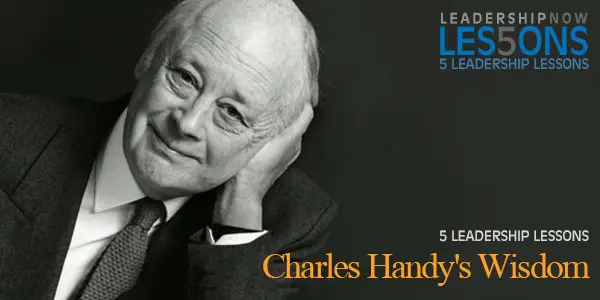
CHARLES HANDY’S memoir, Myself and Other More Important Matters, is full of candid insights from a thoughtful life. Here are a few lessons to take away:
 If all your expectations with life work out well then you probably haven’t pushed yourself far enough. There may be lives out there that you could have lived had you dared more. If all your expectations with life work out well then you probably haven’t pushed yourself far enough. There may be lives out there that you could have lived had you dared more.
 I learnt that in most human situations there is no textbook answer, that everyone is different and that you have to make your own judgments most of the time, make your own decisions and then stand by them. Only in technical matters does the expert know better. I learnt that in most human situations there is no textbook answer, that everyone is different and that you have to make your own judgments most of the time, make your own decisions and then stand by them. Only in technical matters does the expert know better.
 Schools, at every level, prefer to teach what can be taught, rather than what needs to be learnt. Schools, at every level, prefer to teach what can be taught, rather than what needs to be learnt.
 Organizations are not machines. Organizations are not machines.
They are living communities of individuals. To describe them we need to use the language of communities and the language of individuals. The essential task of leadership is to combine the aspirations and needs of the individuals with the purposes of the larger community to which they belong. You do not need to be a genius to see that the task is much easier if the leader knows what the purpose of the community should be and can convince everyone of its importance.
 My belief is that most people have a fundamental understanding of what makes organizations work. They just need to be reminded of it and encouraged to apply their understanding to their own work. The late Sumantra Goshal of the London Business School once described Peter Drucker as practising the scholarship of common sense. I would like that said of me. For example, it is only common sense that people are more likely to be committed to a cause or mission if they had a hand in shaping it. That does not need research to prove it. Nor do you have to see the research to know that groups are likely to produce better results than the same individuals acting on their own. My belief is that most people have a fundamental understanding of what makes organizations work. They just need to be reminded of it and encouraged to apply their understanding to their own work. The late Sumantra Goshal of the London Business School once described Peter Drucker as practising the scholarship of common sense. I would like that said of me. For example, it is only common sense that people are more likely to be committed to a cause or mission if they had a hand in shaping it. That does not need research to prove it. Nor do you have to see the research to know that groups are likely to produce better results than the same individuals acting on their own.
* * *  Like us on Instagram and Facebook for additional leadership and personal development ideas.
* * *


 
Posted by Michael McKinney at 07:10 AM
Permalink
| Comments (0)
| Five Lessons
01.30.08

5 Leadership Lessons: Inside Welch's Communication Revolution at GE
Bill Lane joined GE as a speechwriter in 1980, and became the Manager, Executive Communications for the Company, and Jack Welch’s speechwriter. In his book Jacked Up: Inside Welch's Communication Revolution at GE, he tells stories from his experiences with Jack Welch and other key players, with the candor that Welch prized above all.
 The vanity of communications is about never – ever – allowing anything but your best face, and that of your organization, to ever, ever, appear in front of your constituencies or your employees or your mates.
 I fell prey to a typical attitudinal conceit, a root cause of presentation disasters: the belief that what you think is so important is also considered to be so by the audience. The best presentations I’ve done in my life are ones about which people I respected came up and said: “It was great, but it was too short. I wanted to hear more.” All first draft presentations are too long and should be cut. Second, third, and forth drafts should be cut further.
 Never, ever, make a presentation you do not feel is excellent—a home run. If you don’t spring up to the podium because you can’t wait to do it, something is probably wrong.
 The domination or orchestration of company meetings may sound like the machinations of a control freak, a meddler, an autocrat, or dictator. That is precisely what I am describing; but it also the picture of a leader, and how a leader can capture ownership of his key meetings and his organizational communications, virtually overnight. These meetings were Jack’s megaphone, and everybody knew it. Do the people who attend your key meetings know whose thoughts a views they are hearing?
 [Jack] would tune out, and write-off, people who made presentations that had an air of “going through the motions” or “reporting” rather than passionately advocating some course or other. He loved the latter even if he disagreed with the course being suggested. Any presentation that does not give the people in the audience something they can take out the door with them and use is a failure and a waste of their time. The question always in your mind must not be, “Do I care about this?” But, “Will they care about this?”; “Should they care about this?” Don’t walk out there and bore people.
Lane asks: "What jobs are you disqualifying yourself from because of poor presentation skills? These efforts are fairly easy to acquire, and involve the architecture and effort in the presentation itself, rather than theatrics and what color dress you wear."
Posted by Michael McKinney at 09:24 AM
Permalink
| Comments (0)
| TrackBacks (1) | Communication
, Five Lessons
01.14.08

5 Leadership Lessons: What is Your Intention?
Our intentions—our attitude going in—has a profound affect on the results we get and the stress we experience along the way. Our intentions affect what we do, what we say and how we say it and how we come across in the process. Greg Hicks of Foster, Hicks and Associates and author of LeaderShock, writes that we are so in the grip of LeaderShock—overwhelmed, overloaded and overstressed—that we find ourselves so busy doing that we don’t take time to choose our attitude. We end up allowing it to control us rather than the reverse. “Because attitude animates your actions, once your attitude is set you’re in the best position to decide what behavior is going to work best.” Here are five leadership lessons on Intention from LeaderShock:
 When we don’t assertively set our Intentions, we passively or unconsciously choose something else. Our outcomes are haphazard, and we become hostage to people and events that lead us astray. Intention adds directionality and power to human endeavor.
 Choosing your day isn’t about denying problems, sugarcoating them, or guaranteeing specific results. It’s about intensifying your focus on that which is uplifting and self affirming.
 The Rigidity Trap is everywhere. By locking into rigid assumptions we rarely achieve what we want. Chaos is not the opposite of rigidity. Healthy flexibility is where you want to be, inviting unexpected options and discovering new possibilities before making any final decision. If life is indeed a journey, we as leaders would be wise to pay more attention to the odyssey and less to the final destination toward which we’re headed.
 When we find ourselves merely trying to survive the pressures created by limited time, money, and people resources, we tend to take as much as we can. This survival mentality eventually isolates us from a community that could otherwise provide us with everything we want.
 When we see feedback as negative, or give all our power to the person giving the feedback, we set ourselves up for a long, hard fall. Our Intention should be to see feedback as nothing more than new information; never as an attack.
Posted by Michael McKinney at 03:10 PM
Permalink
| Comments (0)
| Five Lessons
12.10.07

5 Leadership Lessons: Great Advice from Accidental CEO, David Novak
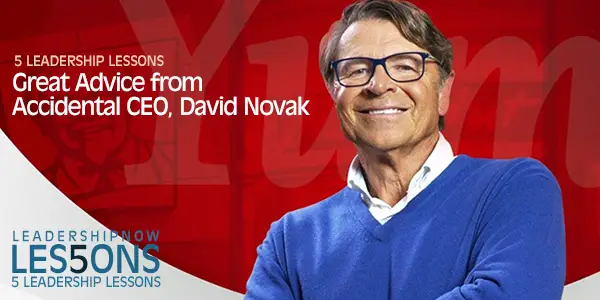
WHILE Yum Brands chairman and CEO David Novak calls himself an accidental CEO, his rise to the top, while perhaps not planned, was no accident. His advancement speaks to the power of right choices made throughout life based on the knowledge gained from cultivating lessons from life and seeking out advice. His memoir, The Education of an Accidental CEO, is written in the first person and full of advice that we can all gain from reading. Nothing here is earth-shaking or new, but it is helpful to see the successful working of these principles in the life of someone who took them to heart. Here are a few of the lessons we can take away:
 I don’t think as a leader that you just go tell people to do something. I believe you plant the seeds and share with them what you know and let them draw their own conclusions—which may even be better than your own. I don’t think as a leader that you just go tell people to do something. I believe you plant the seeds and share with them what you know and let them draw their own conclusions—which may even be better than your own.
 One thing I’ve learned over the years is that you never get promoted until most people in your company can already see you in the position. [Former chairman of PepsiCo, Wayne Calloway], took me aside and said to me, “David, I have no doubt that one day you are going to end up running something. So why don’t you just focus on what you need to do today in order to be ready when you get there.” One thing I’ve learned over the years is that you never get promoted until most people in your company can already see you in the position. [Former chairman of PepsiCo, Wayne Calloway], took me aside and said to me, “David, I have no doubt that one day you are going to end up running something. So why don’t you just focus on what you need to do today in order to be ready when you get there.”
 I can’t stress enough the essential nature of really hearing what someone has to say even if it is totally contradictory to your own beliefs….It’s something that I have to constantly remind myself of, and others, to do to this day. [Coach Wooden told him], “Most leaders have enough ego as it is, so you don’t need anyone around to inflate it any further. I can’t stress enough the essential nature of really hearing what someone has to say even if it is totally contradictory to your own beliefs….It’s something that I have to constantly remind myself of, and others, to do to this day. [Coach Wooden told him], “Most leaders have enough ego as it is, so you don’t need anyone around to inflate it any further.
Have strong, opinionated people working for you.”
 One of the greatest failures to execute is the lack of follow-up. This seems obvious, yet very few companies place as much emphasis on accountability as they do on figuring out what they want to get done. One of the greatest failures to execute is the lack of follow-up. This seems obvious, yet very few companies place as much emphasis on accountability as they do on figuring out what they want to get done.
 Self discovery is the key to learning, whether it’s learning how to do something new or better or learning something about yourself. You can tell the same thing to people a thousand times, but they don’t really own it until they discover it for themselves. Self discovery is the key to learning, whether it’s learning how to do something new or better or learning something about yourself. You can tell the same thing to people a thousand times, but they don’t really own it until they discover it for themselves.
* * *  Follow us on Instagram and Twitter for additional leadership and personal development ideas.
* * *

Posted by Michael McKinney at 10:55 AM
Permalink
| Comments (0)
| Books
, Five Lessons
11.26.07

5 Leadership Lessons: James M. Kilts on Building the Right Team
In his instructive memoir Doing What Matters, James Kilts gives credit to his team for the turnaround he engineered at Gillette. Picking the right people is key to the success of any team. Here are some of his thoughts on building the right team.
 Effort is the price of admission. Everyone has to work hard, usually very hard. But if that effort doesn’t turn into results, something is wrong. Perhaps with the objectives or targets that were set. Or with the actions being pursued. Or maybe with the person involved. Whatever it is, effort without results indicates a problem that must be addressed.
 Former Kraft CEO Mike Miles said, “We had a rule at Kraft that we were not going to hire any self-centered jerks.” Mime believes that there are enough smart people in the world so “you could pass up the smart jerks and wait for a smart, nice person to come through the door. If you did that you would have a society or culture . . . where people enjoyed their cohorts, [and] where they looked forward to coming to work every day.”
 Weed out bad actors. Often, these were self-absorbed people who wanted to run a fiefdom in which their word was unquestioned. They were self-promoters who had no interest in developing people their people or working for corporate goals. Meeting individual targets and achieving personal self-fulfillment defined their efforts.
 I especially like battle-tested managers. People who have had an easy road through there career and never ran into a tough business situation can be unreliable and unpredictable. If you observe someone when they are going through a difficult business situation, you learn a lot. You know if they can keep their composure, think clearly, and deliver the facts, honestly and with transparency, regardless of how bad the news.
 The team aspect of leadership cannot be overstated. The team must be committed to the leader, but even more important, the leader must be committed to the team and to goals that go beyond your own self interest. You must believe in and be committed to the corporate objectives, to organizational goals, and you must give them a top priority.
Posted by Michael McKinney at 10:46 AM
Permalink
| Comments (0)
| Five Lessons
, Teamwork
08.27.07

5 Leadership Lessons: Measure of a Leader
Aubrey and James Daniels wrote a comprehensive and thoughtful book on leadership entitled, Measure of a Leader. It is a book that deserves far more attention. The premise is a new model of leadership that focuses on the behavior of followers. By becoming a better observer of human behavior we can become better leaders. They say that “most leadership writers limit their premises to the success of the leader at his or her particular venture.” There’s more to it than that. How you accomplish something is as important (if not more important) than what you accomplish. Here are a few lessons from their book:
 In any undertaking that requires leadership, loyalty to the individual may be how the venture starts, but it is not how that venture thrives. If the leader cannot transfer personal loyalty to his vision, he has failed one of the critical tests of effective leadership.
 When change exposes individuals to failure and punishment, they resist. When change increases the person’s access to reinforcement, they seek it out. Since one of the leader’s key functions is to lead change, he must view resistance as a signal that something is wrong with the process being used to achieve desired change rather than simply passing off the resistance to change as a normal characteristic of human behavior. Contrary to common opinion, it is not normal!
 Learning to lead is a function of deliberate practice. You refine your techniques and skills by observing the followers’ responses. While you may pick up some pointers from the stories of others, you cannot simply imitate what they do. This intentional search for the impact of your actions will set you apart from those who try to replicate the actions of other leaders.
 Managers need to learn the following rule: you don’t lead by results; you lead to results; and only behavior will get you there. It is important to differentiate between behavior and non-behavior. Of course, attitudes are not behaviors; competencies are not behaviors; values are not behaviors; employee involvement and commitment are not behaviors. Asking someone to smile more often may be infinitely more helpful than telling him to change his attitude.
 Learning leadership is fundamentally a self-management task. But this task is made immensely more difficult if you think of it in terms of changing your personality, such as becoming more charismatic. Since leadership is defined in terms of the behavior of the followers, the task is to ask, “What do I want my followers to do?” and then “What must I do to produce that behavior?”
Posted by Michael McKinney at 10:48 AM
Permalink
| Comments (0)
| Books
, Five Lessons
, Leadership Development
06.25.07

5 Leadership Lessons: What Really Matters According to John Pepper
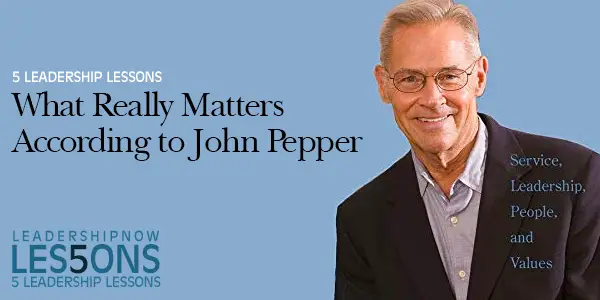
FORMER president, CEO, and chairman of Procter & Gamble, John Pepper has written a very friendly and open account of his forty years at P&G. He spends a good third of What Really Matters describing his rise up the corporate ladder—what he did do and what he would not do again—and how learned to build and manage leading product brands. He stresses the importance of building a community of leaders and leadership within a company and promoting from within whenever possible.
 “[A] characteristic of a vital community is holding ourselves accountable for delivering leadership results and being leaders in all that we do. A culture of leadership binds a community together as nothing else will. By achieving leadership, an institution attracts winners who will then motivate and energize each other to become even better. I cannot overstate the importance of this.” “[A] characteristic of a vital community is holding ourselves accountable for delivering leadership results and being leaders in all that we do. A culture of leadership binds a community together as nothing else will. By achieving leadership, an institution attracts winners who will then motivate and energize each other to become even better. I cannot overstate the importance of this.”
 “Over the years, I’ve seen that the strongest leaders are those who have enough confidence to seek input from others without losing the direction provided by their own internal compass. They understand that the objective of learning is not comfortable consensus. It is to make wiser, more informed choices.” “Over the years, I’ve seen that the strongest leaders are those who have enough confidence to seek input from others without losing the direction provided by their own internal compass. They understand that the objective of learning is not comfortable consensus. It is to make wiser, more informed choices.”
 “We need to recognize that everything in our institutions, everything in life, depends on personal leadership, and personal leadership in turn depends on our being faithful to ourselves. Leadership is not some academic or abstract concept. It is very personal. Personal leadership makes things happen. Determine how you can best be of service in a particular situation, and you’ll know how to lead.” “We need to recognize that everything in our institutions, everything in life, depends on personal leadership, and personal leadership in turn depends on our being faithful to ourselves. Leadership is not some academic or abstract concept. It is very personal. Personal leadership makes things happen. Determine how you can best be of service in a particular situation, and you’ll know how to lead.”
 “Positive feedback sustains people, provided it’s authentic. Honest conversation sustains all of us when it is with someone we respect. Why? Because it shows we matter.” “Positive feedback sustains people, provided it’s authentic. Honest conversation sustains all of us when it is with someone we respect. Why? Because it shows we matter.”
 “Personal ownership is, above all else, something we do for ourselves. It is a choice we make by throwing ourselves into a business and by developing intimate contact with it. But we can nurture and encourage ownership among one another. How? By conveying trust and high expectations, authentically and honestly. Knowing you are trusted contributes mightily to your feelings of ownership. Just as some comments and questions can suppress a sense of ownership, others can turn it on. Consider the power of the simple question: How do you think we should do this?”
* * *  Follow us on Instagram and Twitter for additional leadership and personal development ideas.
* * *


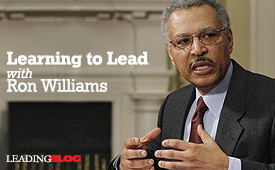 
Posted by Michael McKinney at 08:27 AM
Permalink
| Comments (0)
| Five Lessons
03.26.07

5 Leadership Lessons: Getting Unstuck

Getting Unstuck: How Dead Ends Become New Paths by Timothy Butler is an interesting look at a chronic human problem: not being able to see the forest for the trees. There are times when we get stuck and find ourselves stewing in our own juices.
Our stuck feeling comes from our inability to get our thinking moving again. Sometimes, we get hit so hard that it is hard to get our mind off of the point of impact and instead focus on our response. The decision to get on with it frees us to rally our resources and broaden our repertoire of responses. We will, with the proper outlook, grow to a higher capacity to handle the next crisis that life throws at us.
Bulter offers these thoughts:
 “When we are at an impasse, we often cannot even sense this flow [the connection we feel to the energy in our life] — or to see how close we are to a dynamic dislodging that would place us back into the energy of the moving current….When we have run aground, we sometimes fail to realize that this is a necessary crisis; without it we cannot grow, change, and — eventually — live more fully in a larger world.” “When we are at an impasse, we often cannot even sense this flow [the connection we feel to the energy in our life] — or to see how close we are to a dynamic dislodging that would place us back into the energy of the moving current….When we have run aground, we sometimes fail to realize that this is a necessary crisis; without it we cannot grow, change, and — eventually — live more fully in a larger world.”
 “Self-images often seem to have lives of their own, separate from our daily reality, and they exert a powerful presence that affects decisions and distorts perceptions. These distortions lead us away from the ability to pursue the work and the relationship that hold the greatest promise for fulfillment.” These self-images keep us suck. “Self-images often seem to have lives of their own, separate from our daily reality, and they exert a powerful presence that affects decisions and distorts perceptions. These distortions lead us away from the ability to pursue the work and the relationship that hold the greatest promise for fulfillment.” These self-images keep us suck.
 “The problem with any mental model is that it is always operating on information from the past. In contrast, true vision is never an arrangement or rearrangement of solutions that have worked in previous circumstances but springs from the immediacy of today….Life is always breaking our mental model…A life shock momentarily awakens something in us, and for a moment we are fully alive, with no model at all. We all want this, to be touched directly by life itself.” “The problem with any mental model is that it is always operating on information from the past. In contrast, true vision is never an arrangement or rearrangement of solutions that have worked in previous circumstances but springs from the immediacy of today….Life is always breaking our mental model…A life shock momentarily awakens something in us, and for a moment we are fully alive, with no model at all. We all want this, to be touched directly by life itself.”
 “When we are at an impasse, we need new information, especially information about what is missing rather than a summary of what is already there.” “When we are at an impasse, we need new information, especially information about what is missing rather than a summary of what is already there.”
 Getting unstuck ultimately comes down to a choice. Our lives do not change without action. “The only way forward is to bring our whole person into the tension of the choice. The temptation when experiencing the tensions of a difficult choice is to seek a quick compromise, to find some middle ground that seems to offer some of the best of the conflicting poles. This rarely works and rarely satisfies.” Getting unstuck ultimately comes down to a choice. Our lives do not change without action. “The only way forward is to bring our whole person into the tension of the choice. The temptation when experiencing the tensions of a difficult choice is to seek a quick compromise, to find some middle ground that seems to offer some of the best of the conflicting poles. This rarely works and rarely satisfies.”
Butler offers some practical ways to get ourselves thinking again through practicing free attention and some healthy ways of looking at crisis in our life. His One Hundred Jobs Exercise presented in this book is aimed at helping us to reexamine our outmoded mental models and identify essential work and life themes that will bring us back to our place (authentic) where we can offer our contribution.
* * *  Follow us on Instagram and X for additional leadership and personal development ideas.
* * *

Posted by Michael McKinney at 09:06 AM
Permalink
| Comments (0)
| Books
, Change
, Five Lessons
01.24.07

5 Leadership Lessons from Robin Sharma
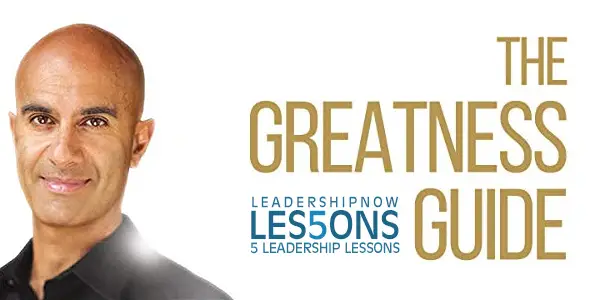
THESE five lessons are from The Greatness Guide by speaker and leadership coach, Robin Sharma.
 The ultimate competitive advantage of your enterprise comes down to a single imperative—your ability to grow and develop leaders faster than your competition. The more quickly you can get every single person in the company demonstrating leadership behavior—regardless of their position—the more quickly you will lead the field. The ultimate competitive advantage of your enterprise comes down to a single imperative—your ability to grow and develop leaders faster than your competition. The more quickly you can get every single person in the company demonstrating leadership behavior—regardless of their position—the more quickly you will lead the field.
 Being a leader isn’t about being liked. It’s about doing what’s right. Great leaders run their own race, making the right decisions and worrying little about public opinion. They are courage in action. Being a leader isn’t about being liked. It’s about doing what’s right. Great leaders run their own race, making the right decisions and worrying little about public opinion. They are courage in action.
 Try not to teach your fears to your kids. Introduce your children to what’s possible. If you see the world as a place of limitation, so will those little people you are raising. Try not to teach your fears to your kids. Introduce your children to what’s possible. If you see the world as a place of limitation, so will those little people you are raising.
 Every day, life will send you little windows of opportunity. Your destiny will ultimately be defined by how you respond to these windows of opportunity. Shrink from them and your life will be small. Feel the fear and run to them anyway and your life will be big. Every day, life will send you little windows of opportunity. Your destiny will ultimately be defined by how you respond to these windows of opportunity. Shrink from them and your life will be small. Feel the fear and run to them anyway and your life will be big.
 Remember, every great leader (or visionary or brave thinker) was initially laughed at. Now they are revered. Push the envelope. Refuse to accept anything remotely close to mediocrity. Let go of the chains that have bound you to the ordinary. And definitely leave the crowd. Remember, every great leader (or visionary or brave thinker) was initially laughed at. Now they are revered. Push the envelope. Refuse to accept anything remotely close to mediocrity. Let go of the chains that have bound you to the ordinary. And definitely leave the crowd.
* * *  Follow us on Instagram and Twitter for additional leadership and personal development ideas.
* * *


 
Posted by Michael McKinney at 08:59 AM
Permalink
| Comments (0)
| Five Lessons
, Personal Development
01.03.07

5 Leadership Lessons: Leadership and Motivation
 A wise leader will involve the team in decision-making as far as possible, for the more that people share in decisions that affect their working life the more they are motivated to carry them out.
 50/50 Principle 50/50 Principle: Fifty per cent of our motivation comes from within us and 50 per cent from without us—from our environment, especially the people around us. (These proportions may vary from person to person.) We are more like open systems than closed boxes.
 Nobody inspires you more than the person who speaks to the greatness within you.
 A Framework for Motivation:
1. Be motivated yourself. You can’t light a fire with a dead match.
2. Select people who are highly motivated. Build your team not from those who talk enthusiastically but from those who show eagerness for the business and steady commitment in their actions.
3. Treat each person as an individual. Theories and principles apply to the generality of people. You will never know how they apply, even if they apply, to any given individuals unless you observe them and talk to them. A good shepherd knows his sheep by name.
4. Set realistic and challenging targets. Your skill as a leader is to set and agree to goals, objectives or targets that both achieve the task and develop the team and its individual members.
5. Remember that progress motivates. If you as a leader can show your team, and to each individual member, that progress is being made, that it itself will feed the determination to press forwards on the path of success.
6. Create a motivating environment. Leaders are there to build teamwork, and that is a creative activity. All leaders in an organization should work together to ensure that it is an interesting, stimulating and challenging place of work.
7. Provide fair rewards. The perception of unfair rewards does have a de-motivating effect on most people. Financial and other rewards should match he relative value of contribution, according to the market assessment for any particular kind of work.
8. Give recognition. A good leader should be swift to show recognition to all members of the team or organization, however indirect their contribution is to the overall task.
 Work as a form of service requiring skill, work that calls for creativity in all its rich variety, work that fosters a deep comradeship with our co-workers, is almost by definition work that motivates us to give our best.  Or, putting it differently, when, as Kahil Gibran says, “Work is the expression of love, then motivation will never be our problem." Perhaps the real challenge of leadership today is to locate, release and channel the power of love that flows from deep inner springs within us all.
These five lessons are from Leadership and Motivation by internationally recognized leadership authority John Adair.
Posted by Michael McKinney at 08:40 AM
Permalink
| Comments (0)
| Five Lessons
, Motivation
|
 |
BUILD YOUR KNOWLEDGE
ADVERTISE WITH US





How to Do Your Start-Up Right
STRAIGHT TALK FOR START-UPS



Grow Your Leadership Skills
NEW AND UPCOMING LEADERSHIP BOOKS

Leadership Minute
BITE-SIZE CONCEPTS YOU CAN CHEW ON

Classic Leadership Books
BOOKS TO READ BEFORE YOU LEAD
|
 |
|






















































































































































 Or, putting it differently, when, as Kahil Gibran says, “Work is the expression of love, then motivation will never be our problem." Perhaps the real challenge of leadership today is to locate, release and channel the power of love that flows from deep inner springs within us all.
Or, putting it differently, when, as Kahil Gibran says, “Work is the expression of love, then motivation will never be our problem." Perhaps the real challenge of leadership today is to locate, release and channel the power of love that flows from deep inner springs within us all.




